#pythagoras trousers
Explore tagged Tumblr posts
Text

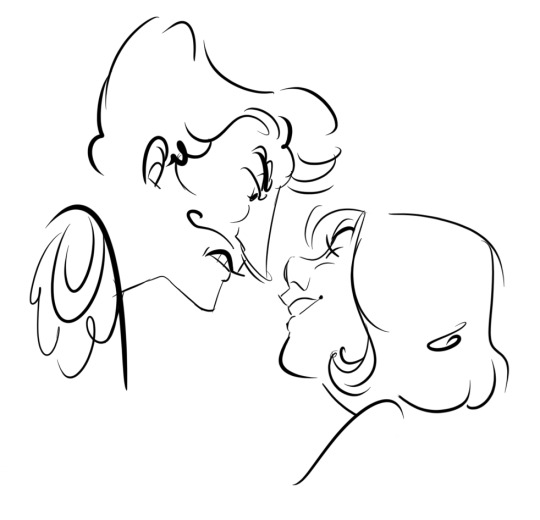
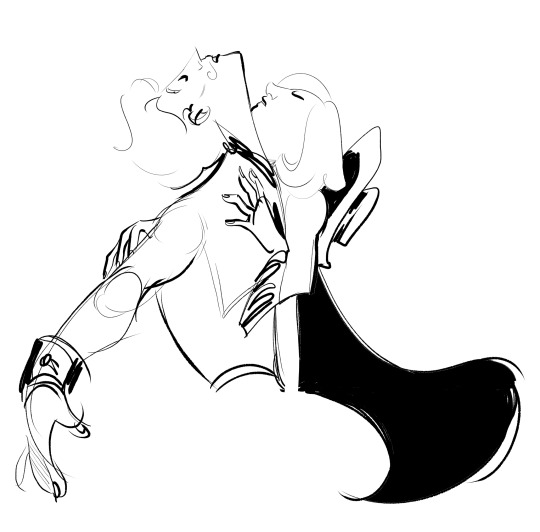

my roman empire
4 notes
·
View notes
Text
Jjk Men College Au
Headcannons
Nanami Kento
Finance Major
Blonde neatly styled hair, sharp cheekbones, thin lips, light brown eyes, glasses pushed up the nose bridge, dark circles, well-groomed and tidy, looks more professional than the professor, you thought he was a professor when you first saw him, calm and composed, stoic, mature, responsible and reliable, emotionally intelligent, good with people, helpful, no-nonsense-adult attitude, pragmatic, cynical, intelligent, tactical, tech-savvy.
Early morning lectures, blue dress shirts, khaki trousers, leopard print ties, networking, finance club, seminars, workshops, turns in assignments before due date, stockbroker internships, libraries, desk lamps, late night study sessions, midnight snacks, ink pens, vintage cars, leather seats, cracking knuckles, strained shoulder muscles, working out, not compromising on physical health despite having a demanding major, does jujutsu as hobby.
College-personal life balance, strength of character, disciplined, organized, heartthrob (unaware), husband material, would probably fall for someone just as diligent as him.
Ryomen Sukuna
Kinesiology Major
Red hair, fiery personality, strength, endurance, gym, MMA fighter, training, late night MMA matches, muscles, tattoos, tattoo artist best friend, frat parties, alcohol, girls, messy sex life, doesn’t do relationships, toxic, fans and fan clubs, future MMA champion, media coverage, athletic, strong-headed, willpower, intelligent, calculative, cunning, missing lectures, top ranker despite not studying much, arrogant, crazy, borderline criminal, don’t try to date him pls.
Leather jackets, ripped jeans, cologne, smirk, loud, reckless, always on the move, fights, wins, clubs, stays up late, doesn’t care, bad boy persona, high status, no commitments, love for chaos. Tension in the air when he enters, always the center of attention, fans everywhere, no time for weakness, doesn’t need to try.
Tattoo sleeve, arms covered, history of fights, scars, reputation, strength, untouchable, doesn’t play by rules, barely attends class, still aces it. Smirks, keeps moving, doesn’t stop. Drinks, casual, no relationships, cold heart. Only more battles ahead, all eyes on him, unpredictable, dangerous, charming.
Geto Suguru
Philosophy Major
Long black hair, weird side bangs, manbun, hidden tattoos, sharp dresser, classic casual but always expensive, calm and composed, mysterious yet friendly to those who matter.
Religious studies, top student, always reading something deep, debates with professors over lunch, having lunch with professors, doing pottery in his free time, sharp opinions, loud thoughts, a little racist, has a vision for an ideal society, probably loves Pythagoras and his cult, wishes to have something similar, always scribbling down ideas in random places, likes to keep things classy but low-key, sharp, calculating, deeply invested in his beliefs.
Volunteers at orphanages, good with children, art hobbies, loves to talk about philosophy, sometimes found debating late at night in the library, always in deep thought, a bit of a perfectionist, not easily impressed by others, enjoys challenging people intellectually, likes to put effort into his appearance, always carrying books on ethics, metaphysics, and society.
Popular amongst women, Gojo’s best friend, your grandma would probably like him, friendly but keeps a bit of distance, doesn’t open up easily but will be there for you when needed, composed around strangers, warm to those he’s close to, respects loyalty, his ideal partner would be someone with similar intelligence and values.
Gojo Satoru
Business major
6'4, blue eyes, trust fund guy, loud, jolly, eccentric, talented, arrogant, sarcastic, wants to make friends but misunderstood by those around him, comes off as off-putting, rich family, only heir, prodigy, diamond spoon kid, first in everything, Geto's best friend.
Gets bullied because of his white hair, shades, blindfolds, people think he has some weird kink, has fangirls regardless, popular loner, sharp dresser, stands out, hates attention, smirk always in place, makes people uncomfortable with his confidence, carefree but secretly lonely, sharp-tongued, cracks jokes all the time.
Easily gets on people's bad side, works to keep up his image, loves challenging authority, doesn't care about consequences, fiercely protective of his friends, holds grudges, always first to show up, leaves last, high-profile business role in his future, a bit of mystery that draws people in, keeps everyone at arm's length.
Wants to be understood, still pushes people away, walks into a room and demands attention, but doesn’t say a word, people notice him immediately, no one dares challenge him, but it’s not for lack of trying, takes classes seriously, skips boring ones, coffee in hand, shades indoors, professors secretly like him, students admire or fear him.
Doesn’t attend study groups, pulls through with perfect grades, natural intelligence, picks up info quickly, a bit of a mystery, high-profile events, networking, parties, center of attention at social gatherings, random comments that leave people laughing or wondering, doesn’t care about others, secretly craves connection but too prideful to ask for it.
---
Do not copy, plagiarise, translate or repost any of my content.
Likes, reblogs, and feedback is appreciated <3
#jjk#jujutsu kaisen#jujutsu kaisen manga#jujutsu kaisen anime#jjk headcanons#gojo satoru#jjk gojo#jjk satoru#geto suguru#jjk geto suguru#jjk geto#jjk suguru#nanami kento#jjk nanami#jjk nanami kento#jjk kento#ryomen sukuna#sukuna#jjk sukuna#jjk ryomen#jjk ryomen sukuna#jjk fanfic#jjk fanfiction#jujutsu kaisen fanfic#satoru gojo#jujutsu kaisen gojo#suguru geto#jujutsu kaisen geto#jujutsu kaisen nanami#sukuna ryo blog
102 notes
·
View notes
Note
Touhou Fangame Concept:
Western Science Interrogating Wonder(title could be workshopped)
The bit is that a bunch of greek philosophers have washed up on this side of the Hakurei Barrier, after the Yama assigned to their collective case(which has gone on for thousands of years) decided that it wasn't worth trying to continue to argue with them kicked them out of the afterlife in frustration. And so you, local Hakurei Shrine Maiden, are set to clean up the mess. By Yukari.
Your first encounter is, after having been drawn to a ruckus going on in the Human Village, being interrogated by a short, grumpy woman in greek looking clothing, and a dunce cap with a sprig of hemlock pinned to it. After defeating her in a danmaku battle that mostly consists of her criticizing you and interrogating your faith, your justifications for your actions, your sense of personal morality, your fashion sense, and if you lose your skill in danmaku. After you beat her she then introduces herself as Socrates, clarifies she puts the dunce cap on herself, and follows Reimu around for the rest of the game to provide commentary.
Your next encounter is a slovenly doggirl with floppy ears in a dirty tunic, who gets out of her barrel to spit in your face after she identifies you as a local religious figure. Reimu then decides to beat the tar out of her. Her mid-battle dialogue consists of complaining about you in particular. After the fight, she gets stuffed back into her barrel and rolled out of town. You get her name from Socrates after the fact, that being Diogenes, who assures Reimu that she's always like this.
Interrogating a nearby villager points you in the direction of the next philosopher, Pythagoras. She's wearing a golden wreath, trousers, and the kind of smile that makes you want to wipe if off. She (flirtatiously)asks if Reimu wants to join her following, expounding upon both her own virtues and the virtue of her teachings. Her spell cards are themed around various legends from Pythagoras's life, like an arrow gifted by Apollo, a bear convinced to never again harm a living being, and that one time they supposedly descended to the underworld and came back. Her danmaku projectiles are specifically rotating triangles. Notably after you defeat her she's still trying to proposition Reimu, even if she's given up on recruitment.
Moving on you find a very tall, broad, woman with a great deal of jewelry(no idea on an appropriate hat) speaking with Keine, and then after having her identified as Plato(another philosopher) by Socrates Reimu proceeds to beat the tar out of her. Her Spell Cards are themed mostly around the Theory of Forms, and defeating her reveals that she was teaching Keine about platonic philosophy with the intent to integrate it into her school's curriculum.
There's this whole bit where Reimu explains how teaching humans to interrogate the world around them like that would just repeat the course of the outside world, and that that would lead to an escalation of conflict between humans and Yokai to maintain the existing balance and preserve Gensokyo. So, very dangerous and likely to lead to a lot of violence. Turning Keine away from all of Plato's ideas. Socrates is being her usual self during all of this and keeps interjecting with interrogative questions and asking why why why before getting a seal slapped over her mouth to shut her up. But not before mentioning that if you're trying to stop the spread of "logic" and "common sense" you should really be going after Aristotle.
So off the shrine maiden goes and indeed, she manages to track where her next target is by a seeming aura of sensibility and "reality". Reimu needs to float outside the boundaries of common sense to keep moving forward, and eventually she encounters a woman in noble ancient greek dress outside the village, talking to a crowd of villagers who were previously working the fields. After beating her in a fight and having it explained to them that they were being lied to by a malicious yokai, things start going back to normal and balance is preserved. Yukari pops in to scoop up the unconscious Aristotle and points you in the direction of the last remaining disruption, while Socrates laughs at and mocks her fellow philosopher for being so confident in her understanding of the world around her because of things like "logic" and "reasoning" and "observation".
The last boss of the Incident is a second fight with Diogenes, who's gotten group of villagers to listen to her about how being human is overrated, and that they'd do well to stop caring about pretense and belief and live like dogs. Effectively the opposite problem presented by Aristotle. It's shown that she originally wasn't even trying during the first fight, and now that Reimu is actually trying to stop her from speaking she actually fights back.
After the fight, you get an epilogue where Yukari asks Reimu about her impression of them all, and eventually decides that they can be permitted to stay now that they've all been shown to be mad, and Socrates' constant insistence that you truly know nothing is more helpful to the preservation of belief than it is harmful. So the lot of them are allowed to set up a school a ways outside the human village, which nobody seriously attends. Partly because of their bad reputation, partly because they're always arguing, and partly because none of them can deliver a straight answer to any question.
Mechanically it's part visual novel and part boss rush, as the setting of the human village doesn't really lend itself to stages full of mooks trying to stop you. And of course there are some design concepts that could be workshopped if this would ever be seriously made. As it stands it's just a fun idea to rotate in your head and laugh about.
really good idea but i especially love the idea that after you beat all these fucking transgenderised clowns they're allowed to stay because if there's two things that the ancient greek philosophers were it was completely wrong and completely deranged
#touhou game idea asks#[voice of the yama] yeah they can't stay in hell but a place full of women is basically hell for a dude from ancient greece#also archimedes should be the extra boss. no philosophy here but she's thrilled to find a place that her laser actually works
66 notes
·
View notes
Text
UNSYSTEMATIC FEELS
Alike the paged up, etched scars that you see every so often appearing once or twice every week. The water that you let flow down your hair, right to your feet; standing atop the cold tiled floor, looking straight, down, with your unclear stance. He lets it sink; the transparent droplets slowly abashed his every piece of well-healed skin.
He turns the knob and head straight to drying his hair while looking at himself at the mirror. He saw another, another piece of symmetrical history that has been unconsciously popping up with every slow push he tilts in; it seems never-ending at this rate.
With his trousers on he heads towards the living room’s sofa; sitting still and looking up; he rethinks, in this tantalising quietness, spiralling a little out of control with every pint of expired liquid pouring into every cells that ��pinch’ at his senses, his fading rhythm ignites with a drown of unyielding tide.
It is unclear how long time has passed him by, not until he heard the pattering outside his window; rain. Always, always, quieting down his brain. He stood up and walked over to look down at the terrains. The slow down cars, the opening of umbrellas, and the lit up lamp that powers on every time the sky darkens. For him, it is much quieter this way; feeling the liquor in his vein, dissipates. As if the eyes that pries his every stature evaporates, he is finally able to, rethink.
He is no longer abiding with the crucified case of self-hate. He was free years ago when he ran forward towards a different game; pacing himself slowly to adjust what his mind could portray and convey. A little knock of cold glass on his head, he recalls how everything became a clear ache. With no more new scars of his during a play.
Maybe it didn’t matter how the fizz looks in their wake; maybe it’s just a means of escape.To the world he was never normal in his wake; and to him, the world has always been abnormal to escape. This shaded landscape.
“I’m so done with this unsystematic roulette."
____________________
QUOTE OF THE DAY:
“There is geometry in the humming of the strings, there is music in the spacing of the spheres.” - Pythagoras
#short reads#short story#writing#creative writing#writing community#original writing#spilled ink#spilled words#literature#life quotes#quotes
3 notes
·
View notes
Text
Chapter 1074 — Mark III
Really enjoying the current arc! Although I do wonder what happened with Law and Kid from time to time, the mysteries of Egghead are really piling up.
First, the cover story is amazing:
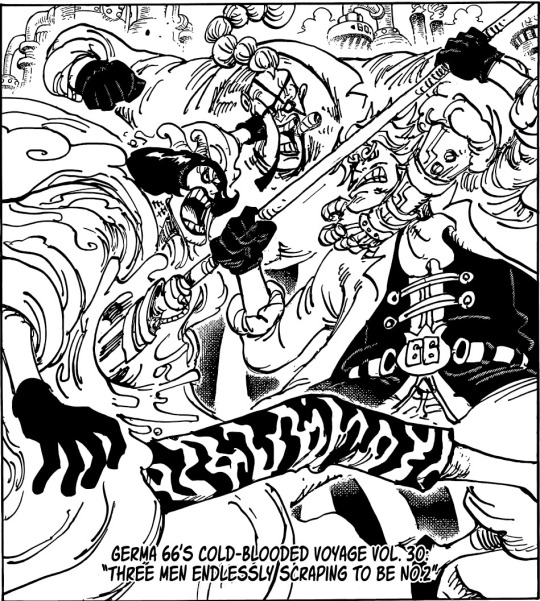
Nice little three-way brawl. Although Caesar has his powers, Queen doesn’t seem too cybernetically enhanced yet, although he does have that lovely mechanical arm to strangle Judge with. I wonder if he lost it in an accident or he changed it himself?
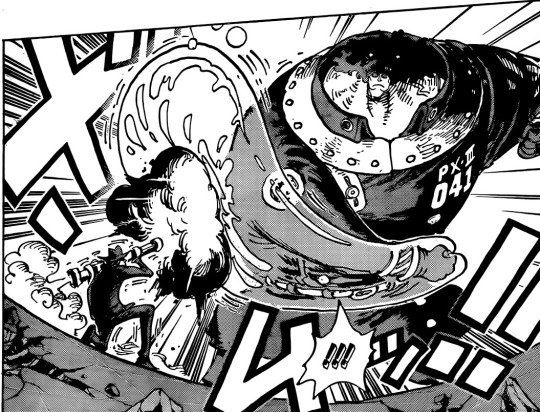
The Bubble Shield is cool! And Oda once again does what he does so well and shows without telling: the bubble can withstand a blast from a bazooka at point blank range. Impressive.
I wonder what happened with Pacifista Mark II?
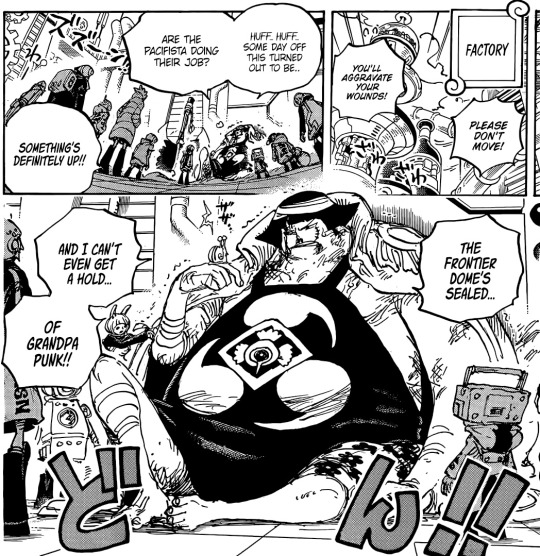
Poor Sentomaru, all shaky and beat :( but the resolve is strong! And he must be quite a beloved fixture on Egghead for the people to care so much about him.
Radio Head dude in the bottom right corner is cute.
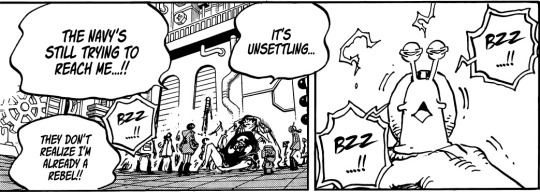
Why is it unsettling that your employer tries to reach you in matters pertaining to your work, Sentomaru? Something you’d rather not talk about, Sentomaru? Everything fine at Egghead, Sentomaru?
I wonder if Kizaru is the Admiral in charge of the Special Science Group? His Sabaody interactions with Sentomaru and the fact that he’s on his way now would indicate this to be the case.
And the spread of the week!
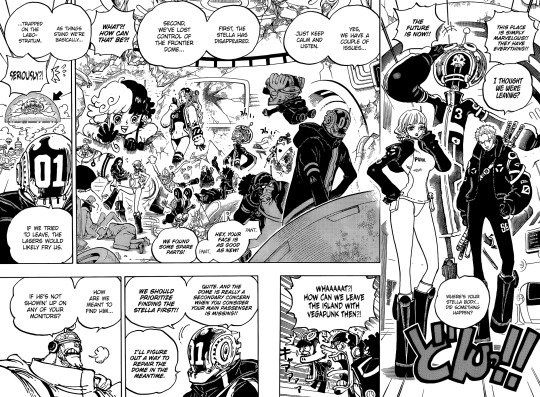
a) Zoro makes the future drip
b) York is one tall lady (but Sanji doesn’t discriminate, he loves all the ladies!)
c) Robin, stopping Nami from kicking Robin’s former, unconscious, tormentors says something profound about both women
d) Please Oda, just…give the ladies some trousers, OK?
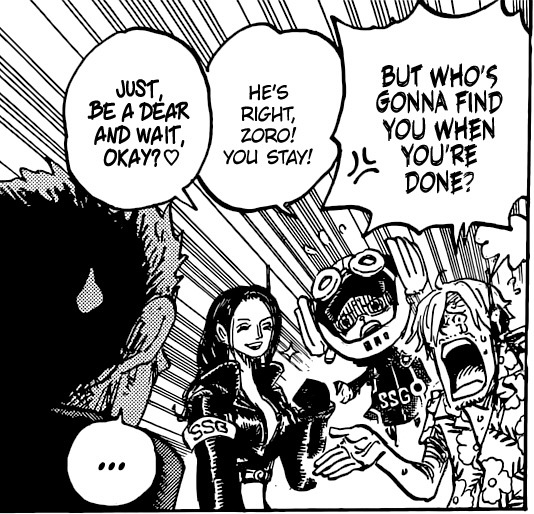
I do enjoy the ongoing gag of Zoro’s total lack of sense of direction. Not sure if Sanji’s sarcastic here, with tears in his eyes, but Robin’s supportive clenched fist and smile is really cute (although her words are harsh).

And “I always go all out for everything” is such a Luffy statement <3
It’s nice that Luffy and Zoro get a moment to just relax.
However, you guys should really know that it’s a horrible idea to split up into smaller groups when something isn’t right as evidenced by the laser dome being operational. Do not split up! THERE IS A MOLE IN YOUR MIDST (mirroring Stussy, I presume, which in turn mirrors the double-agenting back in Wano). Maybe figure out that before splitting up into smaller teams?
But before we go into the Christie-esque Whodunnit-mystery: a detour to Bonney.

I thought Vegapunk was still with her, up until this panel. She really let him go quite quickly when she found her father’s memories. Maybe not the best writing (she was determined to kill him for quite a while before this and then she just… lets him go?), but understandable from a plot-perspective.
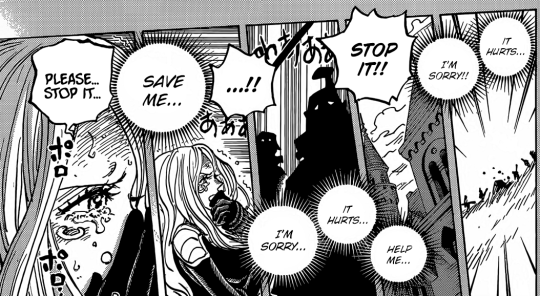
So Kuma was a slave in his childhood and Bonney sees him beaten? Reminiscent of other “see the memories of others” scenes, where the protagonist is helpless in the face of history, unable to change what has already happened. You can only be there and try to understand how it connects to a larger picture.
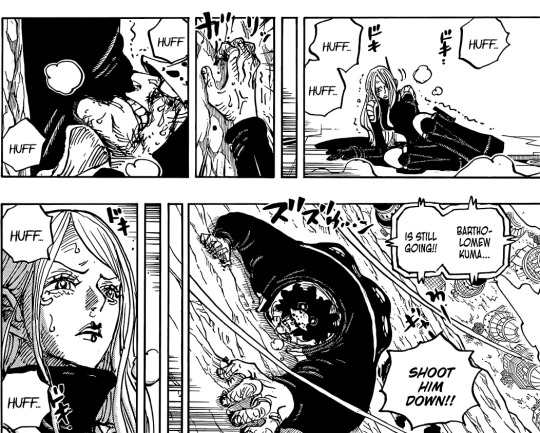
I just wanted to mention this panelling. It’s a really nice mirroring of father and daughter: Bonney covers, a small girl thrown down on the floor, yet Kuma keeps going (where, we don’t know). But then she looks at him (or his memories) and strengthens her resolve: she will see her father and understand him.
Poor Bonney, all shaky yet resolved :(
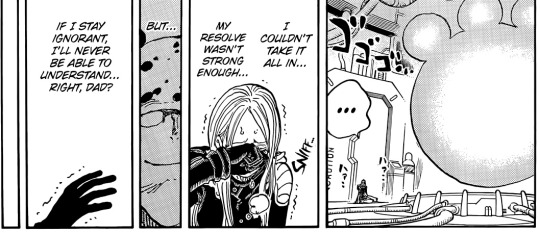
That slice of Kuma’s smile is just… ouch.
There’s probably something to unravel here on the justification (or responsibility) of children bearing their parent’s trauma, but I’m not the one to untangle that ball of knotty yarn.
And back to the Whodunnit part of the show!

Who is it? Who cut off the defenses and enabled CP0 to get up? Who is picking off the Vegapunk Satellites one at a time? A new character or someone we’ve already got to know and love or loathe?
a) One theory is that Urogue will play a larger part in the upcoming arc since all other Supernovas have had their time in the limelight. He is large enough to take on Pythagoras by himself, but he hasn’t been shown to have any connection to Egghead or Vegapunk.
b) The klink and klank suggests either a robot or someone with a large wrench.
c) Is it a Warlord-Pacifista, sneaking inside the lab, fulfilling the orders of Lucci and Kaku?
And the return of Beebs!
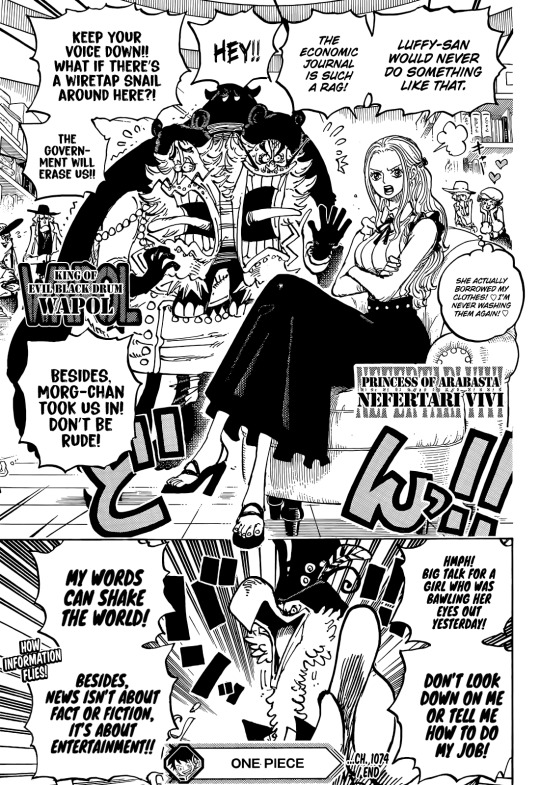
Vivi is very professional-looking here! Nice shirt!
But now i am itching for the backstory. Why is she at the WENP with Wapol of all people? Where is her entourage and his gold-digging wife? What happened after the Reverye and why was she crying yesterday? What is the timespan of all these events?
I really enjoy Morgans. He understands the role he chooses to play a little too well, taking on the mantle of a Murdoch-type slimeball who’s only in it to shape the world into what he wants. Although the government threatened him earlier and they seem to still be on the run, he’s fine with taking their money when spinning the yarn to support their interests.
There’s probably some other meta hiding here about the role of newspapers and how long we’ve had independent, truth-based journalism and if it’s ever been impartial or always entertainment, but, alas, it’s not a piece for me to delve into.
Great chapter, once more! I give it a deerstalker to wear, a gossip rag to write and the strength to face your father’s demons.
25 notes
·
View notes
Text
Dom! Nanami: R18*
Nanami Kento/ F! Reader: Dominant Nanami, Bondage with his tie, rough sex, kind of breeding kink a little bit, spanking.
--------------------------------------------------------
You never thought you'd say the day that Nanami Kento killed you. Undeniably dangerous as he was, the entirety of his aggression was usually always pointed towards the curses he exercised for a living. Never would he raise a finger to an innocent human, so why was he so intent on making you suffer?
He hadn't so much as looked at you since he had gotten you in your compromising position; kneeling at his feet, entirely naked and with a vibrator working away within your cunt. Your hands were restrained behind your back with one of the ties from his extensive collection, a smooth and silky piece of material that wouldn't cause too much chafing. A small act of mercy on his part. The news paper in his hands entirely obstructed your view of his handsome features, and you were desperate for him to put the damned thing away so you could see his face. But alas, he was not relenting.
Your thighs had long since started shaking, entire body quivering with a burning need for the man in front of you. You could feel the cold and cloying wetness of sweat setting on your skin, a byproduct of your body's exertion from being denied orgasm for so long. The vibrator within you was thrumming at much too slow a tempo for it to push you off the precipice and frustrated tears were beginning to well in your eyes.
"Kento-"
You press your forehead to his knee, breaths coming and leaving in heavy puffs. There's not a single response from the man and you adjust with a whine, prickles shooting up your legs which are steadily turning numb.
"Please..."
The silence from him continues, and had you been any less depraved then you were, you'd have half a mind to make a snarky comment asking if he was deaf. You're on the verge of losing hope that you're ever going to garner any kind of acknowledgement from the man, when suddenly, the news paper in his hands is being closed and folded. He tosses it onto the small, round coffee table at his side, before finally, finally, turning those impossibly keen eyes onto your trembling form. Propping his elbow against the arm of the chair, Nanami slots his high cheekbone against his knuckle, peering down at you with a gaze that looks entirely indifferent.
A foot comes up, and your chin is suddenly being hooked onto one of his sleek dress shoes, keeping your hazy and lust-filled eyes on him.
"What is it that you want?"
A shudder runs through you at the sound of his voice. God, you'd never tire of that lazy drawl. You were sure he could sit there and recite pythagoras' theorem to you and you would still be as infinitely aroused as you are.
He rolls your chin slightly with his foot, watching intently as you try to fit your tongue and mouth around the words you want, but each and every attempt at vocalising comes out in no more than broken whines of "please." He isn't pleased with it, evidently, as he sighs and reaches back over for the paper he had only just discarded. Panic bubbles up within you then, and Nanami halts at a broken little cry of "n-no! Wait!"
His eyes are back on you, narrowed now and demanding as the toe of his shoe juts your head up sharply.
"What do you want, (y/n)?"
"You!" Your voice is high in pitch and wavering, body bowed forward towards the warmth of his legs, "you! I-I can't- I need you- please!" your voice trails into whimpered little mumbles, eyes squeezing shut in a desperate attempt to halt the tears that are quickly becoming large enough to fall in streaks down your flushed face. He's quiet again for a moment, listening to your pathetic little snivels and mewls for attention, and the dull buzz of the vibrator that hasn't given you rest for a single moment.
"Look at me."
His demand cuts through the thickening heat of the room, and your eyes open again on command, but just barely. He can see the wet glisten in them, knows that you're getting close to breaking.
"Please what?"
You heave a shaking breath at that. Know exactly what he wants, having given it to him a dozen times before. Keeping your eyes fixed on his as you wet your lips, you find your voice one more time.
"Please Sir."
He hums, considering you for a moment, before the weight of his foot withdraws from under your chin and he stands.
"Get up."
You do as he says, albeit slowly and very wobbly. Almost all of the sensation has left your legs and the painful throb of blood finally returning to the appendages makes it hard to stand on your own, nevermind the fact your hands were bound and unable to help your ascent. Your thighs clench around the toy still firmly lodged and working between them, and Nanami takes silent delight in the little tremors he can spot working their way through your body.
Again, something catches under your chin, his hand this time as he lifts your head to look at him once more, pressing a fleeting kiss to the bitten up flesh of your lips. A low murmur of, "good girl," has you thrilling, before he's catching your bound hands in one of his own, and marching you over to the adjoining dining room table, pressure at your back alerting you that he wants you bent over the thick wood. You do so eagerly, chest and cheek pressing into the solid structure uncomfortably without your hands to cushion you.
Warmth envelops your ass as he presses a hand to either cheek, spreading them to get a better look at the toy slightly protruding from your entrance.
"You're soaked," he comments, fingers accompanying his statement as he drags two digits between your folds; starting at your clit which pulses at the fleeting touch, and stopping at the end of the vibrator. You gasp as he grabs the plastic, removing it slowly from you and turning it off. Relief cuts through you as you relax somewhat against the table, tension ebbing away when you catch a moment to rest. You're vaguely aware of Nanami putting the toy on the table beside you, but you don't pay much mind as you focus on catching your breath for a moment. It is only just a moment however, when a hand makes contact with your behind again, this time as a sharp smack that rings through the room.
You're crying out before you can stop the sound, hands straining against the tie that binds them, body lurching away from the sting.
"Kento!"
"Hmm?"
Another smack. Another yelp, and you're wriggling until the hand that isn't abusing your rear comes to steady you on your hip. Your breathing stops as he leans over, and you can feel the fly on his trousers bite into your ass over his erection. The buttons of his shirt press into your back, and you only manage to find air in a gasp as his breath breezes past your ear.
"Try again."
You're not doing well tonight, you realise. This is the second time you've failed to use his title without him asking, and you imagine that his patience with the matter is swiftly running out. You attempt damage control by whining the honorific out to him, pushing back on your toes and pressing into the hard-on he's sporting. His breath catches for a moment, and then he's swiftly removing himself from you.
"Ordinarily, I'd have you begging until you remember who it is you're addressing," he rumbles and your heart springs into a rapid flutter when the tell-tale sound of his belt coming undone rings through the room, quickly followed by his zipper. You could've sobbed when the head of his cock slides against your lower lips, maybe you do, your brain feels so unaware to anything other than the way his tip bumps over your clit. One of his hands snags your own, keeping them pinned to your back with a firm grip on where the tie stretches between your wrists, his other coming back to rest on your hip once more. And then, he's sneering, "but I think I've kept you waiting long enough."
The sensation of Nanami sliding his cock into you is a feeling you can only describe through a wrecked moan, your toes curling and digging into the polished tile floor. His answering groan seems to come right from the depths of his chest, and you wished once more that you could see his face, but he seems intent on depriving you of that pleasure tonight. The walls of your pussy cling to him eagerly, sucking him in as he bottoms out and you vaguely register the cold metal of his belt buckle against your thigh.
"God, you feel good, love."
The praise is hissed between clenched teeth, and you can do little more than mewl in response as he starts slowly rocking his hips. The languid drag of his cock has you wanting to purr, but not more than the low grunts that punctuate the air every time he sinks his dick back into your waiting warmth. He builds a slow but steady tempo, the smacking of his hips against your ass rhythmic.
Your walls are over sensitive from the vibrator, and you begin to quickly feel the sparks of release buzz between your legs. You want to tell him. Between the satisfied keens and sobs you let out, you try, but they quickly drown out between the sounds of your depravity until all too suddenly, your orgasm hits. Your body seizes as you cum, another loud cry leaving you as it thrums through you and you're left shaking like a leaf against the table. You don't realise Nanami has stopped his movement until your head returns from the clouds, and you think he might be displeased with you for a moment, until he starts to move again.
A squeal tears itself from you as he fucks into you at a pace far more punishing than he had been previously, quickly driving you into overstimulation. His voice is at your ear again, a low growl of, "you're going to cum again for me," and then he's leaning back again, tugging your hips back into every forward drive of his cock. You're entirely incoherent now, babbling dumbly through the pleasure that makes your body burn up, and he matches every single sound with a sneer of his own.
"You're going to take my cum, do you understand? I'm going to fill that little cunt up."
"Yes, Sir!"
"Good girl."
Your climax hits for the second time, and just like he had before, he continues to fuck you through it. You're on the verge of asking him to stop, that it's too much now and you can feel the restrained tears soaking down onto the table, feel the obscene wetness dripping down your thighs, when his pace falters. The exhale he gives is rough and staggered as he swaps his brutal fucking to grind his cock into you in slow pulses, and then, halting entirely as his load paints your insides white. He hisses as his orgasm hits, the grip he has on your bound hands deadly, groin pressed taught into your behind. He stays like that for a few moments, seated snugly inside you until you feel his release begin to leak.
You're still, panting and boneless as his orgasm dispels, eyes closed and exhausted. There's a quiet whine as he pulls out and rights his trousers, but you don't move at all until he's tugging you up carefully against his chest, working the tie off from around your hands. He doesn't collect the fabric, simply let's it pool on the floor. He turns you to face him.
"Are you okay?"
His low voice is barely above a mumble, fingers now gentle as they brush against your cheek, wiping away the path your pleasured tears had made. You respond with a hum and affirmative nod, smiling in a haze against his lips as he kisses you.
"Can you get to bed on your own?" He asks softly, and it's almost as if the question brings awareness of your legs back to you. They ache. Terribly, and you can feel how weak they are, but they should manage to get you to bed before they pack it in for the day. You give him confirmation, and he smiles somewhat.
"I'll clean up here. You get to bed, and I'll join you shortly with a snack and something to drink. If you'd like a bath, you need only tell me and I'll run one for you. I'll give your shoulders and arms a rub too. They were positioned oddly for quite a while."
His insistence makes your body warm and you nod again, indulging in another kiss with the man, before he sends you off with a hand on your back and an utterance of his affection. A statement that you gladly return.
186 notes
·
View notes
Text

Portrait of a young Pythagoras by Bruce Pennington 2010
"Another early teacher who enormously influenced Pythagoras’ life and ideas was Thales, one of the Seven Sages of Antiquity. Thales was an old man when Pythagoras sought him out, and his advice was for Pythagoras to follow in his footsteps and travel to Egypt to learn all he could from the priests there. Young and impetuous, Pythagoras was quick to follow this advice. He looked like a freak as he departed for Egypt with long flowing hair and beard he never cut or shaped. He wore an oriental turban, and Persian trousers made of linen – neither ordinarily seen on the island of Samos, or elsewhere in Greece. In Egypt he was quick to learn to cover his feet in papyrus for shoes. No animal skins were ever used. He spent the next 22 years there, and was a witness to the Persian conquest of Egypt. Greek visitors to Egypt, including Pythagoras, were collected into slavery by the conquering army and transported into Babylon. There Pythagoras’ adventures and occult studies were allowed to continue, probably due to his charisma and talents. He was never mutilated to prevent his fleeing, as were so many slaves, for he had little inclination to depart, and instead assimilated himself into this strange culture and continued to grow. Six years later he was able to buy his freedom. For Pythagoras, it was finally time to journey home to the island of Samos.
Due to his ever-strengthening belief in the transmigration of souls, Pythagoras was obliged to become a vegetarian, to avoid the chance of accidentally eating a friend or relative. It’s reported that one day Pythagoras encountered a man beating his dog. As the dog whimpered and yelped in fear and in pain, Pythagoras recognized the noises as the voice of a recently departed friend. He physically intervened upon the man to release the dog, thus allowing his reincarnated friend to escape a life of misery.
Pythagoras the vegetarian did not only abstain from meat, he didn’t eat beans either. This was because he believed that humans and beans were spawned from the same source, and he conducted a scientific experiment to prove it. He buried a quantity of beans in mud, let them remain there for a few weeks, and then retrieved them. He noted their resemblance to human fetuses, thus convincing himself of the intimate relationship between beans and humans. To eat a bean would therefore be akin to eating human flesh. Equally, to crush, smash, or dirty a bean would be to harm a human. Thus the very strict rule to abstain from beans.
There were many rules to follow if you were to be accepted into the Pythagorean Brotherhood. Fail in any of these and you were likely to be cast out from them with great ceremony. A mock funeral would be performed and you would no longer exist in the minds of the Brotherhood. One rule that could never be broken was the edict to refrain from eating beans.
One bright day a vigorous Pythagoras came upon an ox which was feeding upon beans in a pasture in the region of Tarentum in the south of Italy. Pythagoras informed the startled herdsmen that this must be stopped. He strode across a muddy field and began to speak to the ox in a quiet voice, murmuring into its ear for a long time. Observing all this, the herdsmen broke into fits of laughter. Yet they reported later their startled observation that Pythagoras had convinced the ox to never again desire beans. The locals and visitors to the area thereafter considered the ox to be sacred. The ox, persisting with his new beanless diet, lived to a very old age, well past the lifetime of an ordinary ox.
It took a while for Pythagoras’ career to take hold, and he only found true success when he brought his ideas and his ardent followers to the east coast of Italy, taking residence in the welcoming Greek colony of Croton. There the Pythagorean Brotherhood was able to obtain a strong footing, and its influence soon became widespread. Before long, Pythagoras’ name became known throughout Greece and beyond.
Kylon was the son of a wealthy Crotonate nobleman. Born into nobility, he was used to getting anything he desired. When denied, he could become violent, tyrannical and demanding. Although Kylon had access to all levels of schooling, he proved to be something of a dullard. Nevertheless there came a time when he desired to become a part of the Brotherhood. Because he was a young man of privilege, he believed that he should be allowed to bypass the years of training, silence and deep contemplation which preceded entrance to the inner sanctum of the Brotherhood. Pythagoras bluntly turned him down: and not only was Kylon sent away, but Pythagoras refused a conference with him. Like Hera, Kylon grew angry and vengeful. He was soon giving mock discourses on Pythagorean ideas and beliefs – discourses that characterized the people of Croton as cattle being manipulated and controlled by the Pythagorean leaders. Kylon himself manipulated the emotions of his friends and townspeople, until, as a mob, they descended upon the cluster of houses in which the Brotherhood lived, studied and slept. The angry mob torched the buildings, forcing members of the Brotherhood to flee the terrifying flames. As the members exited the conflagration, many were stabbed to death. Those who escaped both fire and knife fled to the surrounding countryside. Pythagoras was one of the lucky ones: his followers formed a human bridge to help him to clamber out of one of the blazing buildings. But his escape did not go undetected. Soon several of Kylon’s angry friends were in pursuit, yet as he had a significant lead, it looked as if the aging Pythagoras would make it to safety.
Suddenly Pythagoras came to a stop. A vast bean field stretched before him. He stood frozen, uncertain what to do. His eyes focused on a single bean dangling inches from his papyrus- covered feet. So true was he to his ideals that, even at the risk of losing his own life, he was unwilling to trample upon even a single bean. Staring down upon that vibrant bean, the sun low in the sky, he imagined it to be blossoming into a divine ripeness before him. And as he stood there, hesitating, contemplating his next move, his pursuers caught up with him. They lifted their weapons, and bringing the knifes down hard, spilled Pythagoras’ blood on the plants – ending his life for the sake of a bean, and for the deep wisdom immersed in that diminutive cosmic object."
-taken from PhilosophyNow
#ancient greece#greek#pythagoras#pagan#pro life#pentagram#paganism#art#history#ancient history#the soul#reincarnation#magna grecia#egypt#babylon#sketch#vegetarian
10 notes
·
View notes
Text
We Love The Cut-Out Trend But It’s About More Than Just Sex Appeal
In a year when many of us have been wearing little but loungewear, swaddling our bodies in soft rolls of cotton or, if we’re lucky, cashmere, the trend for cut-outs feels like a bolt from the blue. If 2020 has been the year of “soft-talgia” – velour tracksuits standing in for style – then cut-outs could be read as a high-fashion riposte.
In recent collections, slices, squares and gaping holes have been crafted into clothes. Cut-outs add a sense of occasion: when Alexa Chung wanted something that was “spectacular and OTT for what was essentially a Zoom meeting” (The Fashion Awards), she went for a Christopher Kane frock with the sides carved out. On one of the January covers of Vogue, Kate Moss – no stranger to the cut-out look – has been shot wearing a pair of Versace trousers with an artful cut-out on the hip. Emma Corrin was all set to give cut-outs the royal seal of approval by wearing a holey design by Nensi Dojaka to promote The Crown, had the pandemic not put paid to that.
View this post on Instagram
A post shared by Harry Lambert (@harry_lambert)
While some of these cut-out designs will have been sketched long before the name Patrick Vallance entered our daily lexicon, others can be read as either a subconscious or deliberate response to a year in which trackie bottoms have reigned supreme.
Showing skin has long been a red carpet power move. See: Angelina Jolie’s leg at the 2012 Oscars, which still has its own Twitter account. But cut-outs, more than plunging necklines or thigh-high slits, are a way to really frame parts of the body and draw attention to them.
In many ways cut-outs feel like a highbrow take on the naked trend which has been so pervasive in recent years, with sheer frocks and bodycon in muted tones. They perform a sort of peepshow; windows onto the body. It’s incredible what a missing piece of fabric or – reframe that – an artfully placed part of the body can be used to communicate.
Cut-outs are “playing with that issue of hiding and revealing,” Valerie Steele, a fashion historian and director of the Museum at the Fashion Institute of Technology in New York, tells Refinery29. “Concealing … [is] playing – like a fig leaf it’s ambivalent, it calls attention to what it’s supposed to hide.”
“From a designer’s perspective when you have a cut-out you really have the chance to draw attention to a particular body part,” says Michaela Stark, whose work was worn by Beyoncé in the “Apeshit” video and who uses cut-outs unexpectedly and cleverly (more on this later).
View this post on Instagram
A post shared by Michaela Stark (@michaelastark)
While cut-outs might traditionally be thought of as sexy with a capital S, in recent seasons many have been embracing cut-outs that seem almost defiantly the opposite; PG-rated and innocent. At Christopher Kane triangular AW20 cut-outs made up part of the geometric pattern of a dress more Pythagoras than Paphian. London designer Ashley Williams’ AW20 collection includes a dress with a big egg-shaped hole missing from the middle, the perfect frame for one of the body’s most lustless bits: the belly button. Although, as Steele points out, the links to the placenta make it not as far removed from the erotic as you might think.
For many others cut-outs have been a way to put a more unexpected, “wonky sexy” or – dare I say it – empowered spin on designs without necessarily the emphasis on the male gaze; from Dion Lee’s taut leather cut-out dresses shaped like the leaves of a monstera plant to Maximilian Davis’ SS21 collection – a statement “that Black elegance exists” – with its slashed dresses and cut-out-tailored tops.
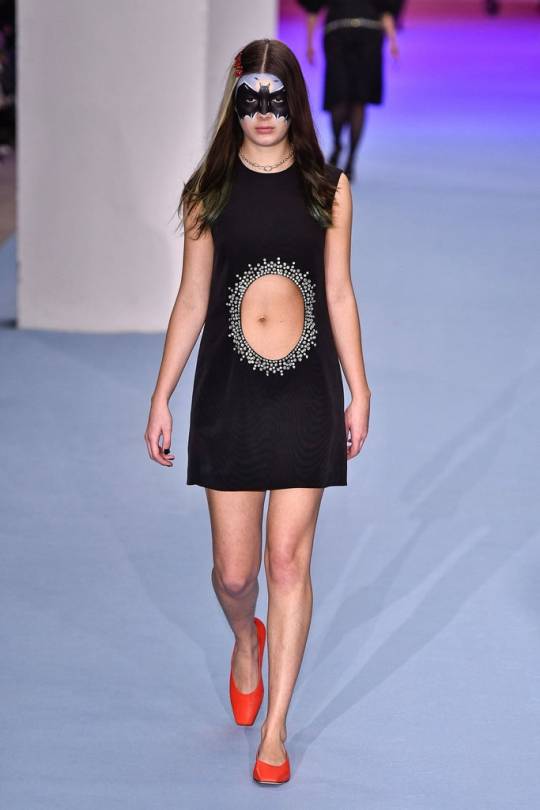

The British-Indian designer Supriya Lele created a collection for SS21 that was a direct response to a year spent in trackie bottoms. As the LVMH Prize-winner recently told Vogue: “I like to show sexual confidence in the clothing and I wanted to make more of a statement of that this season because I felt so tired of wearing joggers for months.” She singles out parts of the body with a surgeon’s precision: a slice of hip here, a slither of torso there.
Bella Hadid-approved designer Nensi Dojaka’s lingerie-inspired designs are often more negative-space than anything else; architectural and strange. Drawing on fashion’s deconstructivist tendencies, Dojaka seems to be playing with the very fabric of what makes a top a top, a dress a dress, and in the process of unpicking and putting back together, she leaves plenty out, bringing focus to parts of the body that perhaps aren’t usually thought of as erogenous.
Wonky cut-outs can be just as potent as those that more strictly adhere to what we traditionally think of as sexy. While the more obviously sexy cut-out might be one that falls squarely over a traditional erogenous zone, Valerie Steele thinks that it almost doesn’t matter where a cut-out falls on the body because “skin implies nakedness and therefore, as Barthes said, eroticism is where the garment gapes, where suddenly you’re showing a flash of skin… If you cover it up and you show a piece of skin then that’s an exciting revelation.”
By bringing focus to the – often female – body, cut-outs ask questions and speak volumes about where we’re at in terms of acceptance of different shapes and sizes in fashion and beyond. It is, generally, much more “acceptable” to wear a midriff-baring dress if your body fits within the narrow limits laid out by society.
Stark is plus-size and creates cut-out-saturated work for herself that could be read as what happens when you take wonky, sexualised cut-outs to their extreme. When she was previously working on “smaller” girls, she says, “I was trying to figure out how to make my designs more sexy and classically beautiful”. A “cutaway would be something that would actually turn the outfit into something more subtle and sexy”; a peekaboo moment. When she turned her focus on herself, it wasn’t not about being sexy but it was also about emphasising “all the parts of my body that I was insecure about.”
View this post on Instagram
A post shared by Michaela Stark (@michaelastark)
Her lingerie designs bind and constrict and surreally sculpt the body. They “make you look at the part that’s the cut-out so the cut-out is so in your face and your eyes are so drawn to it – it makes it more unapologetic.” Through her work she has come to a different understanding of her own body: “I think that when I started I always knew that it was about body acceptance for myself,” she says, “and it has really helped me and the way that I view myself. Now my body is something different – it’s almost like a tool now. When I see fat I know how to make it look beautiful.”
While many of the current cut-out designs in high fashion are shown most routinely on models who fit within the limited ideals of a “model-body-shape”, there are exceptions. A cut-out-rich SS21 collection from Berlin design duo Ottolinger was worn by a cast of models of different body types to stress the universality of their work, and zany designer Collina Strada recently chose plus-size model Alva Claire for a pink dress with cutaways across different stretches of the tummy. Plus, as Stark points out, fast fashion brands like Fashion Nova, for all their sins, “actually know how to dress women amazingly and are doing cut-outs for plus-size women a lot.”
View this post on Instagram
A post shared by ALVA CLAIRE (@alvaclaire)
Stark thinks that change is also coming via women themselves: “Plus-size women are actually starting to put cut-outs in their clothes, maybe even doing DIY cut-outs… They know how to photograph themselves, they know how to work it and are leading by example and the brands are scrambling behind.” It is, she says, “one of those bubbling up effects where plus-size women are taking ownership over their bodies and saying if fashion brands don’t know how to dress me, I know how to dress me.”
Like what you see? How about some more R29 goodness, right here?
After Lockdown, Let's Rediscover Dressing Up
Celebrate Dressing Up For The Holidays
Proof That 'Mutton Dressed As Lamb' Is Bullsh*t
We Love The Cut-Out Trend But It’s About More Than Just Sex Appeal published first on https://mariakistler.tumblr.com/
0 notes
Note
5 for any/all of the P&P soulmark AU, 10 for Common Notions?
5. Did you make an outline for P&P soulmark AU? Did you stick to it?Oh God no. I wish I outlined. I just plunge madly into the froth of scene writing and fill in the “blanks,” as it were, between the loose string of collected bits of dialogue and plot points I want to have happen.10. What are some facts readers may not know about Common Notions?
All my knowledge of French century boarding schools is from a couple of short stories I read once in French class (possibly by Guy de Maupassant), combined with the films Les Choiristes and Au Revoir, Mes Enfants (neither of which are set in the 19th century). I made a half-assed attempt to research how boarding schools in the 19th century would work in France, especially with the added complication of the bac, and the secondary exam for the Grandes Ecoles but couldn’t find anything specific, so I metaphorically threw my hands up in the air and decided this was good enough.
I was also going to write a second sequel, because Euclid had Common Notions, Postulates, and Propositions, but these disconnected bits were all I ended up writing:
“Why are you in a toga?” Combeferre began to ask, but halfway through found the answer, and said, “Nevermind, it’s because of Courfeyrac, isn’t it?”
“Yes, it is always because of Courfeyrac,” agreed Enjolras, with a sort of bemused tolerance.
“Combeferre, I am surprised at you,” came Courfeyrac’s voice from the room beyond. “You have misclassified the evidence before your eyes!”
Combeferre set down his books on Enjolras’s desk, and made himself at home in Enjolras’s chair. Enjolras himself was standing patiently before the fire, in trousers, shirt, and draped bedsheet, looking amused.
“I don’t think I have,” said Combeferre. “Unless, Enjolras, you have decided to follow our friend… is it Jehan now?”
“It is,” came Courfeyrac’s voice. “And technically, that is not a toga but a himaton. We were invited to a symposium!”
***
There were times where Combeferre felt vaguely ashamed of his middle class respectability. The worlds in which an Enjolras of Le Puy-en-Velay and a de Courfeyrac of Grasse danced in costume and whispered revolution over the port and cigars.
***
“Say, if you were a Platonic dialogue, which one do you think you’d be?” asked Courfeyrac. “I’d be The Phaedrus.”
Comebferre snorted. “Yes, of course you would. All flashy speeches on rhetoric.”
“And love at the end,” said Courfeyrac melodramatically. He kissed his hands at Combeferre. “Still, I am glad to have your approval. It makes me feel so well-read. I think you’d be… hm. I think you’re more of a Pythagoras than a Plato.”
“No,” interrupted Enjolras, whom they hadn’t known was still paying attention to their conversation. “Elucid’s Elements.”
Combeferre was not quite sure what to say to this. He was too touched to joke.
“Hm,” said Courfeyrac, lolling about like a cat stretching in a patch of sunlight. “What for Enjolras? Combeferre, I think we might be on the same page– the same title page, I mean, for this one. Three, two, one–”
“The Republic,” they both chorused.
Enjolras was startled into a smile.
“Though, upon reflection, I think this a trick question,” said Courfeyrac. “Enjolras is so clearly a Spartan rather than an Athenian.”
“Really?” asked Enjolras, much amused by this description of himself.
Courfeyrac picked up a copy of the Declaration of the Rights of Man and Citizen and, sliding upright, solemnly presented it to Enjolras.
“With it or on it.”
“It fits too well,” said Combeferre, half-laughing. “Though I cannot call it much of a shield. And it would be very impractical for both its uses. It is impossible to shelter behind it, since the Restoration has robbed it of all legal standing. And abandoning the symbolism for practical matters, it would be impossible to carry a fully grown man on a piece of paper.”
Courfeyrac balled it up and threw it out him.
“Unfair use of the declaration!”
The scuffle that then ensued was entertaining, but rather brief. Combeferre had been to the Polytechnique. He had been trained to win fights, not to flash a fencing foil around in a pretty way.
5 notes
·
View notes
Text







oc cuties
3 notes
·
View notes
Text
PETER STATHAS DANCE – ‘LEAVING AND COMING BACK’

(l-r): Mary McGrath, Lauren Twomley, Selina Hack, Emilee Pratt in CONUNDRUM by Peter Stathas
Peter Stathas began dancing in Wisconsin, then attended SUNY Purchase, and performed with the Jose Limon Dance Company and Marta Renzi. And then, he pursued a successful physical therapy career for thirty years in the Milwaukee area, and rediscovered his interest in choreographing in 2016. He presented an evening of dances at Danspace, June 20-23. Casting dancers from SUNY Purchase and The Limón Company, Stathas showed four dances, spanning from 1985 to the present.
His work lies squarely in the Limón esthetic of interpretive modern dance, and as such, it is earnest and carefully constructed but somehow feels very much of an earlier era. The opening dance, for example, “5 Studies for a Waiter and a Businesswoman” (1985), is just what its title describes. Andrew McShea (waiter) presents himself at the start, doing a series of maneuvers, balancing his tray on an outstretched hand. He’s joined by Lauren Twomley (businesswoman) in a suit and tie, carrying a briefcase.
They do simultaneous solos on opposite sides of the space in rectangles of Kryssy Wright’s resourceful lighting. Then they interact and arm in arm do a little hop/skip phrase back and forth across the space several times, purposely falling out of unison until finally they jibe, merging their disparate characters into one. When the movement isn’t pantomimic, it involves breathy attitude turns and a lot of forward and backward somersaults. The sections feel unfinished, lacking punchlines to drive home their intention. The score is a collage of interesting musical selections by Penguin Café, Harmonic Necklace, Pythagoras Trousers, and others.
“Assuage” is a 2018 dramatic duet, danced to an excerpt from Arvo Pärt’s “Tabula Rasa,” which at first supports but soon overwhelms the emotions in the movement. Stathas created the dance during a workshop with Doug Varone. Jesse Obremski and Twomley – both current Limon Dance members – perform it with skill and passion; their tussle for power shifts between them until in the end, Twomley leaves Obremski alone, effectively winning the battle, as the lights fade.
Barefooted, wearing a suit and tie, and carrying an old-fashioned suitcase, Joe Fransee – a strong, sturdy dancer – virtually pantomimes a recorded text by Stathas, a reminiscence about his grandfather, interspersed with Erik Satie’s delicately sparse “Piéces Froids.” Since the movement illustrates the text without really transcending its literal meaning, the work, “Saturday Mornings,” is a rather sentimental essay.

(l-r): Lauren Twomley and Selina Hack in CONUNDRUM by Peter Stathas
Finally, the New York premiere of “Conundrum” is a four-part piece, set to the Brahms “String Quartet #1 in C Minor, Opus 5.” In the Friday performance, the solo was danced by Twomley, (who alternated performances with Selina Hack) the duet by her and Selina Hack, the trio adds Mary McGrath, and in the quartet, Emilee Pratt joins them.

Selina Hack in CONUNDRUM by Peter Stathas
Costumer Leslie Vaglica dresses the dancers in white, flowing pants and variations of a midriff top. The piece is lyrical in style, driven by the music. The iteration of movement palette we’ve already seen – tumbles, swooping turns, gestural motifs – and a pervasive dynamic evenness, unanchored by character or narrative and unmodulated by stillness or tempo change, make you begin to wish Brahms’s music had either been excerpted or more concise.

(l-r): Selina Hack, Emilee Pratt, Mary McGrath, Lauren Twomley in CONUNDRUM by Peter Stathas
photos by Josh Pacheco
Gus Solomons jr, © 2019
0 notes
Text
The wolf of the woods: Part Three
Word count: 803
-
Wattpad<<<
Warnings: none
-
It was a week later. Dan was back in his treehouse, snoring soundly as it was late at night. He hadn’t stopped thinking about that stranger he’d met while out shopping, his mind kept reliving the encounter and asking multiple questions as to why he seemed so genuine and nice. He thought about his appearance, tall, dark haired and pale. And those eyes, those eyes had been mesmerizing. He had been thinking about that boy way to much, he didn’t even know his name for God’s sake, and it wasn’t like he’d ever see him again.
The sun was beginning to rise. A dim light was beginning to peek through the curtains and Dan started to stir. The silence of the surrounding forest was broken by birdsong which erupted into a chorus of chirps. Dan didn’t need an alarm to wake him up, a particularly loud sparrow perched on his windowsill joining the melody and he soon awoke. Yawning sleepily he pulled his body into a stretch and rubbed his eyes. Now that he could see clearer he looked around the room, he hadn’t bothered to wash up in days and the smashed plate still lay sorrowfully on the floor. He glanced at his moon chart - seventeen days till the next full moon, Then his eyes fell upon the school uniform hanging from his door; his face fell. Today was the day.
Rising half-heartedly from his bed he began to get ready. He pulled on his trousers and buttoned up his shirt, still rather carelessly, and walked over to the sink. He brushed his teeth with a toothbrush he’d stolen a while back (Hygiene is still very important, even for someone without a proper home you know) and peered at himself in his cracked mirror. The bags under his eyes had grown a considerable amount and his hair was a complete mess. Spitting out the toothpaste quite suddenly and turning away from the mirror he reached for his bag and opened the door. He started traipsing down the ladder and, once reaching the bottom, set off through in the direction of school.
A few hours later he was sat in a dull, dusty old classroom, hardly listening to what was going on. He just so happened to be in what was, in his opinion, the very worst lesson: maths. He stared motionlessly at Mrs Lewis, his teacher, with a look of utter bordeom in his eyes as she spoke. She was tall, thin and boney, her slightly crooked nose was shriveled and pointy and her eyes were squinting either side of it. Thin mousy hair drifted down to her shoulders in a rather colourless brown shade, framing her face which appeared to have a positively foul expression.
‘Class’ she addressed them, sharply ‘today we are going to be doing Pythagoras theorem’ she looked around the room and scowled as she heard the moans and groans of Dan’s classmates.
‘hehhem’ she coughed pitilessly and continued. 'as you very well know your exams are coming up, your first being in 18 days time and…’
Dan’s eyes widened, eighteen days time? Why that was the day after the full Moon! Could this day have gotten any worse? He’d already encountered the renowned school bully Seamus, who had tripped him over in the corridor and sneered at him. He knew that test would be a shambles. He wouldn’t change back until sunrise, and spending the night running through the woods as a werewolf always left him feeling so tired… Oh he couldn’t bare to think of how atrocious it was going to be. Still trapped in his thoughts he let out a loud sigh; he then regretted this instantly as the whole class, and Mrs Lewis turned to look at him.
'Is there a problem Daniel?’ she asked menacingly.
'I er, no miss’ he replied, starring at the floor. He could hear Seamus and a few others laughing behind him.
'Good’ she continued, edging closer to him 'Because if there was…’
'Um excuse me Mrs lewis’ Mrs Lewis froze and looked up, there was another teacher standing in the doorway.
'Yes Miss Graham?’
'Well I have a new student with me here today, and he appears to be in your class’ Mrs Graham beamed, she was the total opposite to Mrs Lewis in every way. She had round, plump figure and a jolly face, on which there perched a pair of round spectacles. She stepped forward and beckoned to the apparent new student to follow.
'Class, this is Phil Lester’ she began 'He only moved down here recently and…’
Dan gasped as he looked at Phil, he looked just like… But this boy couldn’t possibly be… Dan looked into his eyes and the shone a glistening greeny-blue. it was him. The stranger he’d met before.
#phan#phanfiction#twotw#phancakeshowell#dan and phil#dan howell#phil lester#danisnotonfire#amazing phil#amazingphil#danisnotonfire and amazingphil#dan howell and phil lester#phanfic#phandom#werewolf!dan
9 notes
·
View notes
Link
Did you know this blog was still a thing? SURPRISE! I’ve just been really, really bad at finishing reviews for the last, uh, three months. Can I blame politics?
0 notes
Text
‘Mảng tối’ của các Giải Nobel
Giải Nobel có uy tín vô cùng lớn đến nỗi nhiều người coi đó là thước đo của chân lý. Tuy nhiên, nếu bạn biết những mảng tối của Giải Nobel, bạn sẽ có cái nhìn thận trọng hơn đối với những tuyên bố của Tổ chức Giải Nobel, chẳng hạn như thông cáo về Giải Nobel Hoá học 2018.
Uy tín của các Giải Nobel là điều không thể chối cãi. Hàng năm cứ đến Tháng 10, mọi người hồi hộp chờ đợi các Thông cáo phát đi từ Tổ chức Giải Nobel (Nobel Prize Organization). Những người đoạt giải được xã hội coi như những cá nhân ưu tú nhất trong cộng đồng nhân loại. Thậm chí, trong con mắt của rất nhiều người, nếu không phải là tất cả, những nhà khoa học đoạt Giải Nobel có thể xem như những “ông thánh khoa học”. Lời lẽ của họ ban ra được xem như “lời của thánh”. Tuyên bố và nhận định của Tổ chức Giải Nobel được xem như những khuôn vàng thước ngọc trong việc đánh giá chân lý.
Với ấn tượng thán phục dành cho Giải Nobel như thế, Giải Nobel Hoá học năm nay, 2018, đã gây nên một cơn “địa chấn” dư luận với hai luồng cảm xúc trái ngược:
“Phe tiến hoá” vui mừng khôn xiết vì những công trình đoạt Giải Nobel Hoá học 2018 đã chứng minh rằng “sự tiến hoá có hướng dẫn” (directed evolution) là một sự thật không thể chối cãi! Bất luận nội dung công trình nghiên cứu này như thế nào, chữ “tiến hoá” đã có mặt trong lý do để đoạt giải thưởng! Các thầy dạy Thuyết tiến hoá tha hồ nói với học trò của mình rằng, “này các em, năm nay Thuyết tiến hoá đoạt Giải Nobel đấy”! Và tất nhiên, học sinh ngây thơ sẽ trố mắt thán phục.
“Phe phản đối thuyết tiến hoá”, một số lấy làm lo lắng, băn khoăn tự hỏi: chẳng lẽ “tiến hoá” là một sự thật hay sao? Số còn lại, những người có hiểu biết vững chắc, không có gì để lo lắng, mà chỉ thấy trách nhiệm của mình là giải thích cho cộng đồng hiểu sự thật: Tổ chức Giải Nobel đã cố tình áp đặt khái niệm “tiến hoá” vào một hiện tượng chẳng nói lên cái gì là tiến hoá cả. Đây chỉ là dịp để mọi người thấy Tổ chức Giải Nobel (bộ phận hoá học) tự giới thiệu mình là một thành phần của “cộng đồng các nhà tiến hoá” mà thôi. Các nhà tiến hoá từng tuyên bố những điều sai sự thật, và đây là một sự kiện tương tự.
Vì thế, sẽ là hữu ích để nói với mọi người về mảng tối của các Giải Nobel. Xin giới thiệu một vài bài báo tiêu biểu nói rõ cho chúng ta biết mảng tối đó:
“ Mảng tối của những nghiên cứu đoạt Giải Nobel ” (The dark side of Nobel prizewinning research), bài của Hugues Honore trên tạp chí PHYS.ORG (Tổ chức Vật lý) ngày 04/10/2015
“ 5 quyết định làm cho Giải Nobel trông xấu xí ” (Five decisions that made the Nobel Prizes look bad), bài của Karl Ritter trên tạp chí PHYS.ORG ngày 01/10/2016
“ Bác bỏ những khám phá đã đoạt Giải Nobel ” (Disproved Discoveries That Won Nobel Prizes), bài của Ross Pomeroy trên tạp chí Real Clear Science (Khoa học Thực Rõ Ràng) ngày 06/10/2015
Mong độc giả tham gia dịch thuật những bài báo nói trên sang tiếng Việt để phổ biến thông tin khoa học đến với mọi người. Sau đây là hai trường hợp sai lầm tiêu biểu của các Giải Nobel đã được nêu lên trong những bài báo đó.
Sai lầm của Giải Nobel Y học năm 1926
Một trong những Giải Nobel gây tranh cãi nhiều nhất là Giải Nobel Y học năm 1926 trao tặng cho Johannes Fibiger, “ vì khám phá ra Spiroptera carcinoma ” – một loài giun ký sinh được cho là gây ra bệnh ung thư ở chuột. Nhưng những nghiên cứu sau này cho thấy mặc dù loài giun ký sinh đó tồn tại, nhưng chúng không phải là nguyên nhân gây ra ung thư. Vậy cái gì đã làm cho Fibiger sai lầm?
[caption id="attachment_992243" align="aligncenter" width="356"] Ảnh: viethungpham.com[/caption]
Bách khoa toàn thư mở Wikipedia cho biết:
“Khi nghiên cứu về bệnh lao của các con chuột trong phòng thí nghiệm, Fibiger nhận thấy một số u trong các con chuột nghiên cứu. Fibiger cho rằng các u này liên quan tới loài giun tròn ký sinh, sống trong các con gián mà chuột đã ăn. Fibiger nghĩ rằng các sinh vật này là nguyên nhân gây ra ung thư. Thực ra, các con chuột đó bị chứng thiếu vitamin A và đó là nguyên nhân chính gây ra các u. Các vật ký sinh kia chỉ đơn thuần gây ra sự kích thích mô, đẩy các tế bào bị hư vào u ung thư”.
Không nên nặng lời chê trách Fibiger hoặc Tổ chức Giải Nobel vì sai lầm này, bởi lẽ vào thời điểm đó, những năm 1920, ung thư là một trong những căn bệnh nan y bí ẩn nhất. Fibiger là một nhà khoa học trung thực đã làm việc không mệt mỏi, mạnh dạn nêu lên các giả thuyết, trong đó ký sinh trùng là một trong những giả thuyết về nguyên nhân gây nên ung thư. Tuy nhiên, sai lầm vẫn là sai lầm. Không thể vì sự thông cảm với Fibiger mà bảo rằng ông không sai hoặc Giải Nobel trao cho ông không sai. Một số người bênh vực Fibiger và Tổ chức Giải Nobel nói rằng “ý tưởng cho rằng mô bị hư là nguyên nhân của bệnh ung thư vẫn là một tiến bộ quan trọng trong nghiên cứu bệnh ung thư”. Nhưng tiến bộ ấy có xứng đáng với Giải Nobel hay không lại là việc hoàn toàn khác. Vả lại, muốn hay không, trong nhận định trao giải thưởng, Tổ chức Giải Nobel đã nhận định sai lầm, vì thừa nhận kết luận của Fibiger rằng ký sinh trùng Spiroptera carcinoma là nguyên nhân dẫn tới ung thư.
Thật vậy, trong một ấn bản năm 1992 của Biên niên sử Y học nội bộ, Tamar Lasky và Paul D. Stolley nhận định:
“Hiện nay chúng ta biết ung thư dạ dày không phải do ký sinh trùng Spiroptera carcinoma gây ra, và “khám phá” có mục đích nói lên mối quan hệ đó dường như không xứng đáng với một chú thích lịch sử, chứ đừng nghĩ tới một giải Nobel”.
Thật trớ trêu, khi tuyên bố lý do trao tặng giải thưởng cho Fibiger, Uỷ ban Nobel đã mô tả công trình của ông là “một ngọn hải đăng toả sáng trong nỗ lực của khoa học tìm kiếm sự thật…”.
Tamar Lasky và Paul Stolley kết luận:
“Câu chuyện của Fibiger đáng kể không chỉ vì nó dạy chúng ta về những cạm bẫy trong nghiên cứu khoa học và lý luận, mà còn vì nó có thể cung cấp sự an ủi cho những người không bao giờ được nhận Giải Nobel (mà xứng đáng được nhận)”
Sai lầm của Giải Nobel Vật lý năm 1938
Nếu ít người được biết sai lầm của Giải Nobel dành cho Fibiger thì có lẽ nhiều người biết sai lầm của Giải Nobel dành cho Enrico Fermi, một nhà vật lý nổi tiếng được ghi nhận như cha đẻ của lò phản ứng hạt nhân đầu tiên ở Chicago, người được khắc tên vào các cuốn sách lịch sử về lý thuyết lượng tử, vật lý hạt nhân và hạt, cơ học thống kê. Nhưng ông cũng giành được một Giải Nobel do nhầm lẫn.
[caption id="attachment_992238" align="aligncenter" width="454"] Ảnh: viethungpham.com[/caption]
Bài báo “Bác bỏ những khám phá đã đoạt Giải Nobel” (đã dẫn ở trên) cho biết:
Fermi đã đoạt Giải Nobel Vật lý năm 1938 “ vì những luận chứng của ông về sự tồn tại của các nguyên tố phóng xạ mới được tạo ra bởi bức xạ neutron, và vì sự phát hiện liên quan đến các phản ứng hạt nhân do các neutron chậm mang lại ”.
Nhưng thực ra Fermi không ch��ng minh được sự tồn tại của các nguyên tố phóng xạ mới.
Khi Fermi bắn phá các nguyên tử uranium với các neutron chuyển động chậm, và quan sát một quá trình được gọi là phân rã beta, ông nghĩ ông đã khám phá ra những nguyên tố mới và thậm chí còn đặt tên cho những nguyên tố mới đó là Ausonium và Hesperium. Nhưng sau này người ta biết rằng những gì ông thực sự làm và vô tình thực hiện chính là sự phân hạch hạt nhân uranium, trong đó các nguyên tử uranium phân chia thành các nguyên tố nhẹ hơn!
Người sau này thực sự thực hiện được phản ứng phân hạch uranium là Otto Hahn và Lise Meitner. Hahn đã đoạt Giải Nobel Hoá học năm 1944, Meitner bị Uỷ ban Nobel “bỏ quên”. Còn Enrico Fermi thì đã thừa nhận mình nhầm lẫn. Không hề có Ausonium và Hesperium, chỉ có nguyên tố thứ 93, Neptunium được tạo ra từ sự phóng xạ uranium.
Tất nhiên Fermi vẫn là người có công lớn khi khám phá ra phương pháp bắn phá uranium bằng neutron chậm, nhưng cả Fermi lẫn Uỷ ban Nobel đều SAI khi cho rằng luận chứng của Fermi chứng minh sự tồn tại của những nguyên tố phóng xạ mới.
Những câu chuyện về sai lầm của các Giải Nobel dạy chúng ta điều gì?
Trước hết nó dạy ta rằng trong khoa học, không có ai là “thánh”. Uỷ ban Nobel không phải là “thánh”, nên những điều họ tuyên bố, bên cạnh nhiều điều là đúng, có không ít điều là SAI.
“Ông Thánh Khoa học” (The Saint Scientific)
Trong cuốn “Pythagoras’ Trousers” (Chiếc quần của Pythagoras) của Margaret Wertheim, do Fourth Estate Ltd xuất bản tại London năm 1997 có một chương đặc biệt, đó là Chương 7: Ông Thánh Khoa học (The Saint Scientific).
[caption id="attachment_992239" align="aligncenter" width="640"] Ảnh: viethungpham.com[/caption]
Đó là một danh hiệu mà tác giả muốn tôn vinh Albert Einstein, bởi khó có thể tưởng tượng một con người bằng xương bằng thịt như chúng ta mà có thể “nghĩ ra” nhiều lý thuyết vĩ đại có tầm vóc bao trùm vũ trụ như Einstein. Mọi lý thuyết vật lý hiện đại dường như đều có “dấu vết” – hệ quả trực tiếp hoặc gián tiếp − từ các lý thuyết của Einstein. Giáo sư vật lý nổi tiếng Nguyễn Hoàng Phương, lúc sinh thời, cũng từng tôn sùng Einstein như một “ông thánh”, ông treo ảnh Einstein ngang hàng với những vị Thánh khác được nhân loại tôn sùng.
Nhưng chính Einstein lại nhắn nhủ người đời rằng “Ai vỗ ngực xưng mình là quyền uy trong lãnh vực chân lý và tri thức thì chỉ làm trò cười cho các thần linh”.
Có nghĩa là mọi người đều có thể mắc sai lầm, và do đó sai lầm của các Giải Nobel là không thể tránh khỏi. Điều quan trọng là mỗi người chúng ta, phải tỉnh táo để nhận thức chân lý.
Không chỉ Tổ chức Giải Nobel có thể nhầm lẫn, mà kể cả các nhà khoa học đoạt Giải Nobel nhiều khi cũng có những tuyên bố phi khoa học đến mức đáng ngạc nhiên. Thí dụ:
George Wald (1906 – 1997)
George Wald là Giáo sư về Khoa học thần kinh tại Đại học Harvard, đoạt Giải Nobel về sinh lý học và y khoa năm 1967, một người mạnh mẽ ủng hộ Thuyết tiến hoá, đặc biệt Thuyết Phi Tạo sinh (Abiogenesis), tức lý thuyết về nguồn gốc sự sống của Thuyết Tiến hoá, một lý thuyết cho rằng sự sống đầu tiên ra đời một cách NGẪU NHIÊN và TỰ PHÁT từ vật chất vô cơ.
Hiếm có một nhà tiến hoá nào chân thật như George Wald. Xin lắng nghe ông bày tỏ lý do vì sao ông ủng hộ Thuyết tiến hoá:
“Chỉ có thể có hai cách giải thích sự sống hình thành như thế nào: 1/ Sự sống hình thành tự phát dẫn tới tiến hóa, hoặc 2/ Sự sống do Chúa sáng tạo… Không có cách giải thích thứ ba. Lý thuyết sự sống hình thành tự phát đã bị bác bỏ về mặt khoa học bởi Louis Pasteur từ 120 năm trước, vì thế chỉ còn cách giải thích là sự sống ra đời bởi tác động siêu nhiên của Chúa. Nhưng tôi không thể chấp nhận triết lý đó bởi vì tôi không muốn tin vào Chúa. Do đó tôi chọn niềm tin vào cái mà tôi biết là bất khả thi về mặt khoa học, đó là sự sống hình thành tự phát dẫn tới tiến hóa”.
Xin nhắc lại để nhấn mạnh: Ông biết rõ rằng lý thuyết sự sống hình thành tự phát là SAI về khoa học, nhưng ông vẫn ủng hộ nó, đơn giản vì ông không còn lựa chọn nào khác! Liệu uy tín của một nhà khoa học đoạt Giải Nobel có đủ để chúng ta tán thành lý do lựa chọn của ông không?
Hơn thế nữa, lý do duy nhất ông dùng để biện mình cho sự ra đời ngẫu nhiên của sự sống đầu tiên từ vật chất không sống là… CƠ MAY, hoặc PHÉP LẠ do THỜI GIAN mang đến!
Đây, ông tuyên bố:
“Với thời gian vô cùng dài, cái “không thể” sẽ trở thành cái có thể, cái có thể sẽ thành cái có khả năng xảy ra, cái có khả năng xảy ra sẽ thành cái thực sự chắc chắn xảy ra. Người ta chỉ cần chờ đợi: thời gian sẽ tự nó trình bày các phép lạ”.
[caption id="attachment_992237" align="aligncenter" width="640"] Ảnh: viethungpham.com[/caption]
Câu nói này có thể dùng để nói với các “con bạc khát nước”, rằng nếu các bạn có thể sống vài trăm triệu năm, trước sau thể nào các bạn cũng sẽ trúng giải độc đắc!
Nói cách khác, George Wald có thể rất giỏi về khoa học chuyên ngành của ông, nhưng xem ra ông chẳng hiểu gì mấy về Lý thuyết Xác suất. Trong lý thuyết này, Émile Borel, một trong những nhà xác suất lớn nhất thế kỷ 20, đã chứng minh rằng mọi sự kiện có xác suất nhỏ hơn (1/10)^50 đều KHỒNG THỂ XẢY RA.
Fred Hoyle , một nhà toán học và thiên văn nổi tiếng người Anh trong thế kỷ 20, đã cùng với sinh viên của mình sử dụng những computer mạnh nhất để tính xác suất cho sự sống hình thành ngẫu nhiên từ vật chất không sống, kết quả bằng (1/10)^40.000 !
Fred Hoyle kết luận:
“Cơ may để sự sống ra đời từ vật chất không sống bằng 1 trên 10 mũ 40.000… Số mũ đó đủ lớn để chôn vùi Darwin cùng toàn bộ thuyết tiến hóa. Không hề có nồi soup nguyên thủy trên hành tinh này hoặc ở bất cứ hành tinh nào khác, và nếu sự khởi đầu của sự sống không phải là ngẫu nhiên thì suy ra nó ắt phải là sản phẩm của trí thông minh có mục đích”.
[caption id="attachment_992234" align="aligncenter" width="640"] Ảnh: viethungpham.com[/caption]
Nhưng bất chấp lý thuyết xác suất, tất cả những người tin vào Học thuyết Darwin và Học thuyết Tân-Darwin đều tin rằng một cơ may ngẫu nhiên, mù quáng, vô mục đích ắt ĐÃ xảy ra từ hàng tỷ năm trước, làm cho các phân tử nguyên tử vô cơ tình cờ kết hợp lại thành sự sống đầu tiên, rồi sự sống ấy “tiến hoá” dần dần thành mọi sinh vật đa dạng như ngày nay!
Một tư tưởng mang đậm tố chất thần thoại như thế lại được coi là một lý thuyết khoa học (!). Lịch sử khoa học chưa bao giờ có sự trớ trêu lớn đến như thế. Các nhà tiến hoá không những không cảm thấy lúng túng khi nói ra những điều thậm vô lý đến như vậy, mà ngược lại, họ còn tự tin cho rằng tư tưởng của mình là độc đáo, đẹp đẽ, và thật “đáng thương” cho những ai không hiểu được niềm tin lãng mạn của họ. Jacques Monod là một nhà tiến hoá nổi tiếng có niềm tin mạnh mẽ hơn ai hết vào Thuyết Phi Tạo sinh.
Jacques Monod (1910 – 1976)
Jacques Monod là một nhà sinh học nổi tiếng, đoạt Giải Nobel về Sinh lý học và y học năm 1965. Ông lớn tiếng tuyên bố:
“Thực chất, một quá trình hoàn toàn mù quáng có thể dẫn tới sự hình thành mọi thứ; thậm chí có thể dẫn tới khả năng nhìn”.
Quá trình mù quáng ở đây là quá trình kết hợp ngẫu nhiên, vô mục đích, tình cờ của các phân tử, nguyên tử vô cơ để tạo thành sự sống đầu tiên!
Thực tiễn sinh học hiện đại đã bác bỏ quan điểm của Jacques Monod, vì mã DNA cho thấy RẤT RÕ rằng sự sống đã được thiết kế có mục đích, có định hướng rõ ràng!
Không có CHƯƠNG TRÌNH của DNA, sự sống sẽ không bao giờ hình thành, bất chấp thời gian tương tác của các phân tử nguyên tử vô cơ là bao nhiêu!
[caption id="attachment_992235" align="aligncenter" width="640"] Ảnh: viethungpham.com[/caption]
DNA là yếu tố quyết định để biến một tập hợp vật chất vô cơ thành sự sống!
Đó là điều Darwin không biết, và ông rất đáng được thông cảm, nhưng thật buồn khi chúng ta thấy những nhà sinh học đoạt Giải Nobel trong nửa sau thế kỷ 20 như George Wald hay Jacques Monod mà cũng không biết! Ảo tưởng về Thuyết Phi Tạo sinh đã che mờ mắt họ!
Vậy, qua hai trường hợp điển hình là George Wald và Jacques Monod, ta học được điều gì?
Xin trả lời:
Một nhà khoa học đoạt Giải Nobel, mặc dù có thể rất giỏi trong chuyên môn hẹp của mình, nhưng vẫn có thể có những ý kiến phi khoa học và phản khoa học!
Thuyết Tiến hoá làm hỏng nhận thức của con người về thế giới!
Ấy thế mà Giải Nobel Hoá học 2018 vẫn cố tuyên truyền cho Thuyết tiến hoá khi nói rằng các công trình được trao giải vì đã chứng minh được “sự tiến hoá có hướng dẫn” (directed evolution)!
Với kinh nghiệm về các Giải Nobel như đã nói ở trên, chúng ta có thể bình tĩnh và tỉnh táo nhận xét tuyên bố của Tổ chức Giải Nobel về Giải Nobel Hoá học 2018.
Về Giải Nobel Hoá học 2018
Để thấy rõ SAI LẦM của Tổ chức Giải Nobel trong việc đánh giá ý nghĩa các công trình đoạt Giải Nobel Hoá học 2018, xin độc giả dành chút thì giờ đọc kỹ bài viết sau của tôi:
“Nghi vấn xoay quanh Giải Nobel Hóa học 2018”
Xin nhắc lại ở đây phần kết luận.
Thực ra, các công trình đoạt Giải Nobel 2018 cho thấy:
Nếu việc tác động đến hệ gene được điều khiển bởi THIỆN CHÍ thì nó có thể dẫn tới những kết quả có ích lợi cho đời sống loài người.
Nếu việc tác động đến hệ gene được điều khiển bởi DÃ TÂM thì nó có thể dẫn tới những kết quả bất lợi hoặc nguy hiểm, đe doạ đời sống loài người.
Trong thực tế, hầu hết tác động làm thay đổi hệ gene đều dẫn tới bệnh hoạn, quái thai, sự chết và tuyệt chủng.
Thành tựu đoạt Giải Nobel Hoá học 2018 hoàn toàn vô nghĩa trong việc chứng minh sự tiến hoá theo kiểu Darwin hoặc Tân Darwin là một sự thật
Khi bài báo này đăng lần đầu tiên trên mạng, một số độc giả đã có những bình luận rất hay và sáng suốt:
Bạn Ng Khoa viết:
Bài viết phân tích rất chi tiết thưa bác. Mấy hôm nay con cũng đang tìm hiểu về cái này, trên báo chỉ toàn ghi là dựa theo thuyết tiến hoá chứ chẳng có ghi thêm bất kỳ chi tiết nào nên đã gây nhiều khó khăn cho con trong quá trình tìm hiểu. Cám ơn bác rất nhiều.
Ông Nguyễn Bình nhận xét:
Bài phân tích của anh Hưng là rất kịp thời và cần thiết để tránh sự hiểu lầm về cái gọi là “tiến hóa” trong thực tiễn hoạt động của sinh giới dù là tự nhiên hay có tác động “hướng dẫn” của con người. Tôi nghĩ thực tế là họ biến đổi một số virus để có những đặc tính có lợi cho việc chữa bệnh hoặc theo mục đích nào đó mà thôi, không thể căn cứ vào đó mà gọi là “tiến hóa” được. Vậy nếu có tiến hóa trong các công trình đó, thì đã tiến hóa ra cái gì?
Đặc biệt, bạn Đỗ Minh Đức lập luận rất sâu sắc:
Thưa bác Hưng, ý kiến của bác trong bài viết này là rất chính xác.
Rõ ràng là những người biên soạn ra nội dung và lý do trao giải cho bà Frances Arnold đã mang sẵn trong tư duy hoặc bị ảnh hưởng bởi tư tưởng của học thuyết Darwin nên mới không phân biệt đươc giữa “tiến hóa và chọn lọc” trong thuyết của Darwin xảy ra trong tự nhiên với “tiến hóa và chọn lọc” có “định hướng” cũng như “tác động” bởi các nhà khoa học trong phòng thí nghiệm.
Thuyết tiến hóa cho rằng các các đột biến tích tụ trong hàng triệu năm, hay hàng tỷ năm, dưới các điều kiện môi trường ngẫu nhiên mà một loài này dần biến đổi thành loài khác.
Trong khi thực chất “directed evolution” là một kỹ thuật di truyền, lai dòng phân tử (giống như lai tạo giống ngô hay lúa mì cho năng suất cao) mà ở đây chính là tạo các enzyme xúc tác có các đặc tính mà các nhà khoa học mong muốn.
Nếu tìm hiểu kỹ, có thể thấy kỹ thuật “directed evolution” có một số thủ tục đặc điểm giống với thuyết tiến hóa, đó là:
1/ Ban đầu gây đột biến lên gene mã hóa cho một enzyme đang cần nghiên cứu, sẽ cho ra một tập hữu hạn các gene đột biến
2/ Phân tách từng gene đột biến rồi từ mẫu này tổng hợp ra các enzyme tương ứng
3/ Mỗi loại enzyme được khuếch đại với số lượng lớn để tính trạng trội của mỗi mẫu được thể hiện
4/ Các nhà khoa học tiến hành thí nghiệm phát hiện, lựa chọn ra tính trạng tối ưu
5/ Từ tính trạng tối ưu này tương ứng với gene mã hóa đột biến, họ đem gene đột biến này lặp lại bước 1 ban đầu.
6/ Sau một số bước lặp, các nhà khoa học sẽ chọn ra được enzyme có tính năng tối ưu nhất cho mục đích nghiên cứu.
Có thể thấy các bước làm trên là hữu hạn (số lượng đột biến là ngẫu nhiên nhưng không quá lớn) trên một dòng protein nhất định, trong thời gian chấp nhận được, thực hiện trong phòng thí nghiệm với những điều kiện ưu thế mà gần như ít gặp trong tự nhiên, và dưới sự kiểm soát và tư duy của nhà khoa học tiến hành thí nghiệm. Các thủ tục này rõ ràng là khác với thuyết tiến hóa: xảy ra trên một tập lớn dữ liệu giữa các loài, trong thời gian dài hàng triệu năm, với điều kiện thăng giáng tác động từ môi trường tự nhiên và hoàn toàn ngẫu nhiên không có một “định hướng” của “thế lực” nào.
Ngay ở trong báo cáo khoa học của Giải Nobel hóa học 2018, chính những người biên soạn đã viết rằng không thể nghiên cứu bằng cách tạo ra đột biến một cách ngẫu nhiên trên từng điểm của gene mã hóa cho chuỗi axit amin (mà thường lớn hơn 200 axit amin) vì đơn giản khi lấy tổ hợp toán học của các đột biến này và các biến dị của nó sẽ cho số lượng rất lớn! (Trang 3 trong [1]) Mà các nhà sinh học chỉ lựa chọn một thư viện với số lượng nhỏ đột biến để nghiên cứu.
Thành tựu được công nhận của bà Frances Arnold đó là đưa ra những kỹ thuật giúp tạo ra được những enzyme có lợi phục vụ trong sản xuất xăng sinh học, tạo ra những phân tử mới không có trong tự nhiên…
Tham khảo:
https://ift.tt/2A8O4VQ
https://ift.tt/2xVjvle
https://ift.tt/2A8EceO
https://ift.tt/2fhwI0m
https://ift.tt/2A8Ed2m
Kết luận
Tổ chức Giải Nobel (bộ phận xét Giải Nobel Hoá học) đã tự lộ diện là một thành viên tích cực của cộng đồng các nhà tiến hoá. Và họ đã áp đặt một khái niệm phi lý là “directed evolution” vào công trình của bà Frances Arnold. Phi lý ở chỗ sử dụng khái niệm “tiến hoá” cho một sự thật chỉ có ý nghĩa “biến hoá’, mà giới tiến hoá thường gọi là “micro-evolution”, một khái niệm bịp bợm, làm cho nhiều người ngỡ rằng tiến hoá là một sự thật.
Khái niệm “directed evolution” phản lại khái niệm “đột biến ngẫu nhiên” của Thuyết Tân-Darwin! Nói cách khác, Giải Nobel Hoá học 2018 vô tình chống lại Thuyết Tân-Darwin ở chỗ khẳng định rằng muốn có “tiến hoá” thì phải có sự HƯỚNG DẪN, ĐỊNH HƯỚNG! Do đó, quy trình đột biến NGẪU NHIÊN, tức là không có hướng dẫn, sẽ không thể dẫn tới tiến hoá. Suy ra Thuyết Tân-Darwin là “impossible!” (bất khả thi), đúng như Lý thuyết xác suất đã tuyên bố!
Tác giả: Phạm Việt Hưng
[caption id="attachment_989788" align="aligncenter" width="320"] GS Phạm Việt Hưng. Ảnh: photobucket[/caption]
Thông tin về tác giả: Giáo sư Phạm Việt Hưng từng giảng dạy các môn Toán Kinh tế; Cơ học Lý thuyết; Sức bền Vật liệu; Toán luyện thi đại học. Hiện ông đang thỉnh giảng Toán cao cấp tại một đại học ở Việt Nam. Ông đang có nhiều hoạt động báo chí với nhiều bài viết được đăng trên nhiều báo in và báo mạng, ví như Khoa học & Đời sống của Hội Liên hiệp Khoa học & Kỹ thuật Việt Nam, Tạp chí Vật lý Ngày nay của Hội Vật lý Việt Nam, Tạp chí Tia Sáng của Bộ Khoa học, Công nghệ và Môi trường, Trang mạng Vietsciences.
Loạt bài sự thật về thuyết tiến hóa
Các bài khác của tác giả Phạm Việt Hưng
from Đại Kỷ Nguyên - Feed - https://ift.tt/2QRwRpL via IFTTT
0 notes
Photo
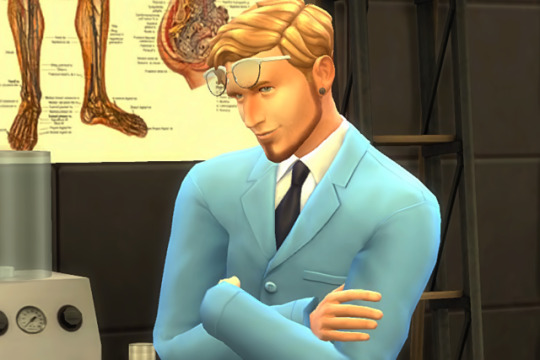
OC question tag - Rules: 1. Pick a character you’ve created. 2. Fill in the questions/statements as if you were that character. 3. Tag at least four people to do this meme
I honestly got tagged on this a few times, but I’m so late doing it, I can’t remember everybody who did. I’m going to have to do this at least twice, I know. Well, here’s Archimedes Fox, which I remember somebody requesting...
QUESTIONS:
1. What is your name? Archimedes Theobald Douglas Fox.
2. Do you know why you were named that? My mother has an obsession with Greek Mathematicians. At least I presumed that.
3. Single or taken? ...It’s complicated.
4. Stop being a Mary Sue! I believe you have me horribly mistaken for somebody else.
5. What’s your eye color? Grey.
6. How about hair color? Blonde.
7. Have you any family members? Yes. Both of my parents are living, as is my surviving brother, Pythagoras. (see what I mean?)
8. Oh, how about pets? I don’t tend to do well with living things.
9. That’s cool, I guess. Now tell me something you don’t like? Stupidity, pettiness, malice, conceit. People who act like they’re God’s gift.
10. Do you have any activities/hobbies that you like to do? Read, solve puzzles, code.
11. Have you ever hurt anyone in any way before? Yes.
12. Ever… killed anyone before? Yes.
13. What kind of animal are you? Homo sapiens.
14. Name your worst weaknesses. I would hardly divulge that to all and sundry, would I?
15. Do you look up to anyone at all? I have few idols. Men are fallible. I admire the traits of a few, however.
16. Are you straight, gay or bisexual? What a dreadfully invasive question; however to satisfy your clearly lurid curiousity, when I engage in sexual activities I prefer to do so with women. I have never remotely been curious about exploring my own gender in that fashion.
17. Do you go to school? I have a doctorate. In medicine no less. I obtained it fairly early and then went on to specialise in forensic sciences; but no, I am not currently enrolled in any given institution of learning.
18. Ever want to marry and have kids one day? It’s not something I’ve ever seriously entertained for a variety of reasons. I’m not opposed to the idea. I simply don’t believe that domestic bliss is my fate.
19. Do you have fangirls/fanboys? Who wrote these questions? What sort of a question is this? Why would anybody even remotely become a fan of a medical examiner/warlock?
20. What are you most afraid of? You do like probing questions, don’t you? I don’t believe I am obliged to answer that.
21. What do you usually wear? Button up shirts with trousers. If the weather is cool, perhaps a jumper or a sweater vest. Oxford shoes or monk-straps. Jackets. I don’t tend to wear too many jeans or tshirts.
22. What’s one food that tempts you? rack of lamb.
23. Am I annoying you? *tight, mild smile* You would have to matter to annoy me.
24. Well, it’s not over! Ah, there’s a cruel surprise *dry tones*
25. What class are you (low class, middle class, high class)? I believe the echelon of society I was born into is referred to as ‘elite’.
26. How many friends do you have? I am a refined man of particular tastes and I vastly prefer quality to quantity. How many friends you have is irrelevant to the depth and breadth of the relationship
27. What are your thoughts on pie? Sweet or savoury?
28. Favourite drink? Red wine or whisky.
29. What’s your favourite place? For all that it’s been a place of exile for me, I’m rather fond of Edenbrück
30. Are you interested in anyone? In what sense? I’m dreadfully attracted to Poppea Fitzpatrick, but you probably knew that already.
31. That was a stupid question. Yes. It was, wasn’t it?
32. Would you rather swim in a lake or the ocean? Is this metaphorical or literal? Metaphorically I’m quite content to be a small fish in a larger ocean.
33. What’s your type? O-negative.
34. Any fetishes? I am a private individual.
35. Camping or indoors? My idea of ‘roughing it’ involves staying in a three star hotel rather than a four star one.
50 notes
·
View notes
Text
‘Mảng tối’ của các Giải Nobel
Giải Nobel có uy tín vô cùng lớn đến nỗi nhiều người coi đó là thước đo của chân lý. Tuy nhiên, nếu bạn biết những mảng tối của Giải Nobel, bạn sẽ có cái nhìn thận trọng hơn đối với những tuyên bố của Tổ chức Giải Nobel, chẳng hạn như thông cáo về Giải Nobel Hoá học 2018.
Uy tín của các Giải Nobel là điều không thể chối cãi. Hàng năm cứ đến Tháng 10, mọi người hồi hộp chờ đợi các Thông cáo phát đi từ Tổ chức Giải Nobel (Nobel Prize Organization). Những người đoạt giải được xã hội coi như những cá nhân ưu tú nhất trong cộng đồng nhân loại. Thậm chí, trong con mắt của rất nhiều người, nếu không phải là tất cả, những nhà khoa học đoạt Giải Nobel có thể xem như những “ông thánh khoa học”. Lời lẽ của họ ban ra được xem như “lời của thánh”. Tuyên bố và nhận định của Tổ chức Giải Nobel được xem như những khuôn vàng thước ngọc trong việc đánh giá chân lý.
Với ấn tượng thán phục dành cho Giải Nobel như thế, Giải Nobel Hoá học năm nay, 2018, đã gây nên một cơn “địa chấn” dư luận với hai luồng cảm xúc trái ngược:
“Phe tiến hoá” vui mừng khôn xiết vì những công trình đoạt Giải Nobel Hoá học 2018 đã chứng minh rằng “sự tiến hoá có hướng dẫn” (directed evolution) là một sự thật không thể chối cãi! Bất luận nội dung công trình nghiên cứu này như thế nào, chữ “tiến hoá” đã có mặt trong lý do để đoạt giải thưởng! Các thầy dạy Thuyết tiến hoá tha hồ nói với học trò của mình rằng, “này các em, năm nay Thuyết tiến hoá đoạt Giải Nobel đấy”! Và tất nhiên, học sinh ngây thơ sẽ trố mắt thán phục.
“Phe phản đối thuyết tiến hoá”, một số lấy làm lo lắng, băn khoăn tự hỏi: chẳng lẽ “tiến hoá” là một sự thật hay sao? Số còn lại, những người có hiểu biết vững chắc, không có gì để lo lắng, mà chỉ thấy trách nhiệm của mình là giải thích cho cộng đồng hiểu sự thật: Tổ chức Giải Nobel đã cố tình áp đặt khái niệm “tiến hoá” vào một hiện tượng chẳng nói lên cái gì là tiến hoá cả. Đây chỉ là dịp để mọi người thấy Tổ chức Giải Nobel (bộ phận hoá học) tự giới thiệu mình là một thành phần của “cộng đồng các nhà tiến hoá” mà thôi. Các nhà tiến hoá từng tuyên bố những điều sai sự thật, và đây là một sự kiện tương tự.
Vì thế, sẽ là hữu ích để nói với mọi người về mảng tối của các Giải Nobel. Xin giới thiệu một vài bài báo tiêu biểu nói rõ cho chúng ta biết mảng tối đó:
“ Mảng tối của những nghiên cứu đoạt Giải Nobel ” (The dark side of Nobel prizewinning research), bài của Hugues Honore trên tạp chí PHYS.ORG (Tổ chức Vật lý) ngày 04/10/2015
“ 5 quyết định làm cho Giải Nobel trông xấu xí ” (Five decisions that made the Nobel Prizes look bad), bài của Karl Ritter trên tạp chí PHYS.ORG ngày 01/10/2016
“ Bác bỏ những khám phá đã đoạt Giải Nobel ” (Disproved Discoveries That Won Nobel Prizes), bài của Ross Pomeroy trên tạp chí Real Clear Science (Khoa học Thực Rõ Ràng) ngày 06/10/2015
Mong độc giả tham gia dịch thuật những bài báo nói trên sang tiếng Việt để phổ biến thông tin khoa học đến với mọi người. Sau đây là hai trường hợp sai lầm tiêu biểu của các Giải Nobel đã được nêu lên trong những bài báo đó.
Sai lầm của Giải Nobel Y học năm 1926
Một trong những Giải Nobel gây tranh cãi nhiều nhất là Giải Nobel Y học năm 1926 trao tặng cho Johannes Fibiger, “ vì khám phá ra Spiroptera carcinoma ” – một loài giun ký sinh được cho là gây ra bệnh ung thư ở chuột. Nhưng những nghiên cứu sau này cho thấy mặc dù loài giun ký sinh đó tồn tại, nhưng chúng không phải là nguyên nhân gây ra ung thư. Vậy cái gì đã làm cho Fibiger sai lầm?
[caption id="attachment_992243" align="aligncenter" width="356"] Ảnh: viethungpham.com[/caption]
Bách khoa toàn thư mở Wikipedia cho biết:
“Khi nghiên cứu về bệnh lao của các con chuột trong phòng thí nghiệm, Fibiger nhận thấy một số u trong các con chuột nghiên cứu. Fibiger cho rằng các u này liên quan tới loài giun tròn ký sinh, sống trong các con gián mà chuột đã ăn. Fibiger nghĩ rằng các sinh vật này là nguyên nhân gây ra ung thư. Thực ra, các con chuột đó bị chứng thiếu vitamin A và đó là nguyên nhân chính gây ra các u. Các vật ký sinh kia chỉ đơn thuần gây ra sự kích thích mô, đẩy các tế bào bị hư vào u ung thư”.
Không nên nặng lời chê trách Fibiger hoặc Tổ chức Giải Nobel vì sai lầm này, bởi lẽ vào thời điểm đó, những năm 1920, ung thư là một trong những căn bệnh nan y bí ẩn nhất. Fibiger là một nhà khoa học trung thực đã làm việc không mệt mỏi, mạnh dạn nêu lên các giả thuyết, trong đó ký sinh trùng là một trong những giả thuyết về nguyên nhân gây nên ung thư. Tuy nhiên, sai lầm vẫn là sai lầm. Không thể vì sự thông cảm với Fibiger mà bảo rằng ông không sai hoặc Giải Nobel trao cho ông không sai. Một số người bênh vực Fibiger và Tổ chức Giải Nobel nói rằng “ý tưởng cho rằng mô bị hư là nguyên nhân của bệnh ung thư vẫn là một tiến bộ quan trọng trong nghiên cứu bệnh ung thư”. Nhưng tiến bộ ấy có xứng đáng với Giải Nobel hay không lại là việc hoàn toàn khác. Vả lại, muốn hay không, trong nhận định trao giải thưởng, Tổ chức Giải Nobel đã nhận định sai lầm, vì thừa nhận kết luận của Fibiger rằng ký sinh trùng Spiroptera carcinoma là nguyên nhân dẫn tới ung thư.
Thật vậy, trong một ấn bản năm 1992 của Biên niên sử Y học nội bộ, Tamar Lasky và Paul D. Stolley nhận định:
“Hiện nay chúng ta biết ung thư dạ dày không phải do ký sinh trùng Spiroptera carcinoma gây ra, và “khám phá” có mục đích nói lên mối quan hệ đó dường như không xứng đáng với một chú thích lịch sử, chứ đừng nghĩ tới một giải Nobel”.
Thật trớ trêu, khi tuyên bố lý do trao tặng giải thưởng cho Fibiger, Uỷ ban Nobel đã mô tả công trình của ông là “một ngọn hải đăng toả sáng trong nỗ lực của khoa học tìm kiếm sự thật…”.
Tamar Lasky và Paul Stolley kết luận:
“Câu chuyện của Fibiger đáng kể không chỉ vì nó dạy chúng ta về những cạm bẫy trong nghiên cứu khoa học và lý luận, mà còn vì nó có thể cung cấp sự an ủi cho những người không bao giờ được nhận Giải Nobel (mà xứng đáng được nhận)”
Sai lầm của Giải Nobel Vật lý năm 1938
Nếu ít người được biết sai lầm của Giải Nobel dành cho Fibiger thì có lẽ nhiều người biết sai lầm của Giải Nobel dành cho Enrico Fermi, một nhà vật lý nổi tiếng được ghi nhận như cha đẻ của lò phản ứng hạt nhân đầu tiên ở Chicago, người được khắc tên vào các cuốn sách lịch sử về lý thuyết lượng tử, vật lý hạt nhân và hạt, cơ học thống kê. Nhưng ông cũng giành được một Giải Nobel do nhầm lẫn.
[caption id="attachment_992238" align="aligncenter" width="454"] Ảnh: viethungpham.com[/caption]
Bài báo “Bác bỏ những khám phá đã đoạt Giải Nobel” (đã dẫn ở trên) cho biết:
Fermi đã đoạt Giải Nobel Vật lý năm 1938 “ vì những luận chứng của ông về sự tồn tại của các nguyên tố phóng xạ mới được tạo ra bởi bức xạ neutron, và vì sự phát hiện liên quan đến các phản ứng hạt nhân do các neutron chậm mang lại ”.
Nhưng thực ra Fermi không chứng minh được sự tồn tại của các nguyên tố phóng xạ mới.
Khi Fermi bắn phá các nguyên tử uranium với các neutron chuyển động chậm, và quan sát một quá trình được gọi là phân rã beta, ông nghĩ ông đã khám phá ra những nguyên tố mới và thậm chí còn đặt tên cho những nguyên tố mới đó là Ausonium và Hesperium. Nhưng sau này người ta biết rằng những gì ông thực sự làm và vô tình thực hiện chính là sự phân hạch hạt nhân uranium, trong đó các nguyên tử uranium phân chia thành các nguyên tố nhẹ hơn!
Người sau này thực sự thực hiện được phản ứng phân hạch uranium là Otto Hahn và Lise Meitner. Hahn đã đoạt Giải Nobel Hoá học năm 1944, Meitner bị Uỷ ban Nobel “bỏ quên”. Còn Enrico Fermi thì đã thừa nhận mình nhầm lẫn. Không hề có Ausonium và Hesperium, chỉ có nguyên tố thứ 93, Neptunium được tạo ra từ sự phóng xạ uranium.
Tất nhiên Fermi vẫn là người có công lớn khi khám phá ra phương pháp bắn phá uranium bằng neutron chậm, nhưng cả Fermi lẫn Uỷ ban Nobel đều SAI khi cho rằng luận chứng của Fermi chứng minh sự tồn tại của những nguyên tố phóng xạ mới.
Những câu chuyện về sai lầm của các Giải Nobel dạy chúng ta điều gì?
Trước hết nó dạy ta rằng trong khoa học, không có ai là “thánh”. Uỷ ban Nobel không phải là “thánh”, nên những điều họ tuyên bố, bên cạnh nhiều điều là đúng, có không ít điều là SAI.
“Ông Thánh Khoa học” (The Saint Scientific)
Trong cuốn “Pythagoras’ Trousers” (Chiếc quần của Pythagoras) của Margaret Wertheim, do Fourth Estate Ltd xuất bản tại London năm 1997 có một chương đặc biệt, đó là Chương 7: Ông Thánh Khoa học (The Saint Scientific).
[caption id="attachment_992239" align="aligncenter" width="640"] Ảnh: viethungpham.com[/caption]
Đó là một danh hiệu mà tác giả muốn tôn vinh Albert Einstein, bởi khó có thể tưởng tượng một con người bằng xương bằng thịt như chúng ta mà có thể “nghĩ ra” nhiều lý thuyết vĩ đại có tầm vóc bao trùm vũ trụ như Einstein. Mọi lý thuyết vật lý hiện đại dường như đều có “dấu vết” – hệ quả trực tiếp hoặc gián tiếp − từ các lý thuyết của Einstein. Giáo sư vật lý nổi tiếng Nguyễn Hoàng Phương, lúc sinh thời, cũng từng tôn sùng Einstein như một “ông thánh”, ông treo ảnh Einstein ngang hàng với những vị Thánh khác được nhân loại tôn sùng.
Nhưng chính Einstein lại nhắn nhủ người đời rằng “Ai vỗ ngực xưng mình là quyền uy trong lãnh vực chân lý và tri thức thì chỉ làm trò cười cho các thần linh”.
Có nghĩa là mọi người đều có thể mắc sai lầm, và do đó sai lầm của các Giải Nobel là không thể tránh khỏi. Điều quan trọng là mỗi người chúng ta, phải tỉnh táo để nhận thức chân lý.
Không chỉ Tổ chức Giải Nobel có thể nhầm lẫn, mà kể cả các nhà khoa học đoạt Giải Nobel nhiều khi cũng có những tuyên bố phi khoa học đến mức đáng ngạc nhiên. Thí dụ:
George Wald (1906 – 1997)
George Wald là Giáo sư về Khoa học thần kinh tại Đại học Harvard, đoạt Giải Nobel về sinh lý học và y khoa năm 1967, một người mạnh mẽ ủng hộ Thuyết tiến hoá, đặc biệt Thuyết Phi Tạo sinh (Abiogenesis), tức lý thuyết về nguồn gốc sự sống của Thuyết Tiến hoá, một lý thuyết cho rằng sự sống đầu tiên ra đời một cách NGẪU NHIÊN và TỰ PHÁT từ vật chất vô cơ.
Hiếm có một nhà tiến hoá nào chân thật như George Wald. Xin lắng nghe ông bày tỏ lý do vì sao ông ủng hộ Thuyết tiến hoá:
“Chỉ có thể có hai cách giải thích sự sống hình thành như thế nào: 1/ Sự sống hình thành tự phát dẫn tới tiến hóa, hoặc 2/ Sự sống do Chúa sáng tạo… Không có cách giải thích thứ ba. Lý thuyết sự sống hình thành tự phát đã bị bác bỏ về mặt khoa học bởi Louis Pasteur từ 120 năm trước, vì thế chỉ còn cách giải thích là sự sống ra đời bởi tác động siêu nhiên của Chúa. Nhưng tôi không thể chấp nhận triết lý đó bởi vì tôi không muốn tin vào Chúa. Do đó tôi chọn niềm tin vào cái mà tôi biết là bất khả thi về mặt khoa học, đó là sự sống hình thành tự phát dẫn tới tiến hóa”.
Xin nhắc lại để nhấn mạnh: Ông biết rõ rằng lý thuyết sự sống hình thành tự phát là SAI về khoa học, nhưng ông vẫn ủng hộ nó, đơn giản vì ông không còn lựa chọn nào khác! Liệu uy tín của một nhà khoa học đoạt Giải Nobel có đủ để chúng ta tán thành lý do lựa chọn của ông không?
Hơn thế nữa, lý do duy nhất ông dùng để biện mình cho sự ra đời ngẫu nhiên của sự sống đầu tiên từ vật chất không sống là… CƠ MAY, hoặc PHÉP LẠ do THỜI GIAN mang đến!
Đây, ông tuyên bố:
“Với thời gian vô cùng dài, cái “không thể” sẽ trở thành cái có thể, cái có thể sẽ thành cái có khả năng xảy ra, cái có khả năng xảy ra sẽ thành cái thực sự chắc chắn xảy ra. Người ta chỉ cần chờ đợi: thời gian sẽ tự nó trình bày các phép lạ”.
[caption id="attachment_992237" align="aligncenter" width="640"] Ảnh: viethungpham.com[/caption]
Câu nói này có thể dùng để nói với các “con bạc khát nước”, rằng nếu các bạn có thể sống vài trăm triệu năm, trước sau thể nào các bạn cũng sẽ trúng giải độc đắc!
Nói cách khác, George Wald có thể rất giỏi về khoa học chuyên ngành của ông, nhưng xem ra ông chẳng hiểu gì mấy về Lý thuyết Xác suất. Trong lý thuyết này, Émile Borel, một trong những nhà xác suất lớn nhất thế kỷ 20, đã chứng minh rằng mọi sự kiện có xác suất nhỏ hơn (1/10)^50 đều KHỒNG THỂ XẢY RA.
Fred Hoyle , một nhà toán học và thiên văn nổi tiếng người Anh trong thế kỷ 20, đã cùng với sinh viên của mình sử dụng những computer mạnh nhất để tính xác suất cho sự sống hình thành ngẫu nhiên từ vật chất không sống, kết quả bằng (1/10)^40.000 !
Fred Hoyle kết luận:
“Cơ may để sự sống ra đời từ vật chất không sống bằng 1 trên 10 mũ 40.000… Số mũ đó đủ lớn để chôn vùi Darwin cùng toàn bộ thuyết tiến hóa. Không hề có nồi soup nguyên thủy trên hành tinh này hoặc ở bất cứ hành tinh nào khác, và nếu sự khởi đầu của sự sống không phải là ngẫu nhiên thì suy ra nó ắt phải là sản phẩm của trí thông minh có mục đích”.
[caption id="attachment_992234" align="aligncenter" width="640"] Ảnh: viethungpham.com[/caption]
Nhưng bất chấp lý thuyết xác suất, tất cả những người tin vào Học thuyết Darwin và Học thuyết Tân-Darwin đều tin rằng một cơ may ngẫu nhiên, mù quáng, vô mục đích ắt ĐÃ xảy ra từ hàng tỷ năm trước, làm cho các phân tử nguyên tử vô cơ tình cờ kết hợp lại thành sự sống đầu tiên, rồi sự sống ấy “tiến hoá” dần dần thành mọi sinh vật đa dạng như ngày nay!
Một tư tưởng mang đậm tố chất thần thoại như thế lại được coi là một lý thuyết khoa học (!). Lịch sử khoa học chưa bao giờ có sự trớ trêu lớn đến như thế. Các nhà tiến hoá không những không cảm thấy lúng túng khi nói ra những điều thậm vô lý đến như vậy, mà ngược lại, họ còn tự tin cho rằng tư tưởng của mình là độc đáo, đẹp đẽ, và thật “đáng thương” cho những ai không hiểu được niềm tin lãng mạn của họ. Jacques Monod là một nhà tiến hoá nổi tiếng có niềm tin mạnh mẽ hơn ai hết vào Thuyết Phi Tạo sinh.
Jacques Monod (1910 – 1976)
Jacques Monod là một nhà sinh học nổi tiếng, đoạt Giải Nobel về Sinh lý học và y học năm 1965. Ông lớn tiếng tuyên bố:
“Thực chất, một quá trình hoàn toàn mù quáng có thể dẫn tới sự hình thành mọi thứ; thậm chí có thể dẫn tới khả năng nhìn”.
Quá trình mù quáng ở đây là quá trình kết hợp ngẫu nhiên, vô mục đích, tình cờ của các phân tử, nguyên tử vô cơ để tạo thành sự sống đầu tiên!
Thực tiễn sinh học hiện đại đã bác bỏ quan điểm của Jacques Monod, vì mã DNA cho thấy RẤT RÕ rằng sự sống đã được thiết kế có mục đích, có định hướng rõ ràng!
Không có CHƯƠNG TRÌNH của DNA, sự sống sẽ không bao giờ hình thành, bất chấp thời gian tương tác của các phân tử nguyên tử vô cơ là bao nhiêu!
[caption id="attachment_992235" align="aligncenter" width="640"] Ảnh: viethungpham.com[/caption]
DNA là yếu tố quyết định để biến một tập hợp vật chất vô cơ thành sự sống!
Đó là điều Darwin không biết, và ông rất đáng được thông cảm, nhưng thật buồn khi chúng ta thấy những nhà sinh học đoạt Giải Nobel trong nửa sau thế kỷ 20 như George Wald hay Jacques Monod mà cũng không biết! Ảo tưởng về Thuyết Phi Tạo sinh đã che mờ mắt họ!
Vậy, qua hai trường hợp điển hình là George Wald và Jacques Monod, ta học được điều gì?
Xin trả lời:
Một nhà khoa học đoạt Giải Nobel, mặc dù có thể rất giỏi trong chuyên môn hẹp của mình, nhưng vẫn có thể có những ý kiến phi khoa học và phản khoa học!
Thuyết Tiến hoá làm hỏng nhận thức của con người về thế giới!
Ấy thế mà Giải Nobel Hoá học 2018 vẫn cố tuyên truyền cho Thuyết tiến hoá khi nói rằng các công trình được trao giải vì đã chứng minh được “sự tiến hoá có hướng dẫn” (directed evolution)!
Với kinh nghiệm về các Giải Nobel như đã nói ở trên, chúng ta có thể bình tĩnh và tỉnh táo nhận xét tuyên bố của Tổ chức Giải Nobel về Giải Nobel Hoá học 2018.
Về Giải Nobel Hoá học 2018
Để thấy rõ SAI LẦM của Tổ chức Giải Nobel trong việc đánh giá ý nghĩa các công trình đoạt Giải Nobel Hoá học 2018, xin độc giả dành chút thì giờ đọc kỹ bài viết sau của tôi:
“Nghi vấn xoay quanh Giải Nobel Hóa học 2018”
Xin nhắc lại ở đây phần kết luận.
Thực ra, các công trình đoạt Giải Nobel 2018 cho thấy:
Nếu việc tác động đến hệ gene được điều khiển bởi THIỆN CHÍ thì nó có thể dẫn tới những kết quả có ích lợi cho đời sống loài người.
Nếu việc tác động đến hệ gene được điều khiển bởi DÃ TÂM thì nó có thể dẫn tới những kết quả bất lợi hoặc nguy hiểm, đe doạ đời sống loài người.
Trong thực tế, hầu hết tác động làm thay đổi hệ gene đều dẫn tới bệnh hoạn, quái thai, sự chết và tuyệt chủng.
Thành tựu đoạt Giải Nobel Hoá học 2018 hoàn toàn vô nghĩa trong việc chứng minh sự tiến hoá theo kiểu Darwin hoặc Tân Darwin là một sự thật
Khi bài báo này đăng lần đầu tiên trên mạng, một số độc giả đã có những bình luận rất hay và sáng suốt:
Bạn Ng Khoa viết:
Bài viết phân tích rất chi tiết thưa bác. Mấy hôm nay con cũng đang tìm hiểu về cái này, trên báo chỉ toàn ghi là dựa theo thuyết tiến hoá chứ chẳng có ghi thêm bất kỳ chi tiết nào nên đã gây nhiều khó khăn cho con trong quá trình tìm hiểu. Cám ơn bác rất nhiều.
Ông Nguyễn Bình nhận xét:
Bài phân tích của anh Hưng là rất kịp thời và cần thiết để tránh sự hiểu lầm về cái gọi là “tiến hóa” trong thực tiễn hoạt động của sinh giới dù là tự nhiên hay có tác động “hướng dẫn” của con người. Tôi nghĩ thực tế là họ biến đổi một số virus để có những đặc tính có lợi cho việc chữa bệnh hoặc theo mục đích nào đó mà thôi, không thể căn cứ vào đó mà gọi là “tiến hóa” được. Vậy nếu có tiến hóa trong các công trình đó, thì đã tiến hóa ra cái gì?
Đặc biệt, bạn Đỗ Minh Đức lập luận rất sâu sắc:
Thưa bác Hưng, ý kiến của bác trong bài viết này là rất chính xác.
Rõ ràng là những người biên soạn ra nội dung và lý do trao giải cho bà Frances Arnold đã mang sẵn trong tư duy hoặc bị ảnh hưởng bởi tư tưởng của học thuyết Darwin nên mới không phân biệt đươc giữa “tiến hóa và chọn lọc” trong thuyết của Darwin xảy ra trong tự nhiên với “tiến hóa và chọn lọc” có “định hướng” cũng như “tác động” bởi các nhà khoa học trong phòng thí nghiệm.
Thuyết tiến hóa cho rằng các các đột biến tích tụ trong hàng triệu năm, hay hàng tỷ năm, dưới các điều kiện môi trường ngẫu nhiên mà một loài này dần biến đổi thành loài khác.
Trong khi thực chất “directed evolution” là một kỹ thuật di truyền, lai dòng phân tử (giống như lai tạo giống ngô hay lúa mì cho năng suất cao) mà ở đây chính là tạo các enzyme xúc tác có các đặc tính mà các nhà khoa học mong muốn.
Nếu tìm hiểu kỹ, có thể thấy kỹ thuật “directed evolution” có một số thủ tục đặc điểm giống với thuyết tiến hóa, đó là:
1/ Ban đầu gây đột biến lên gene mã hóa cho một enzyme đang cần nghiên cứu, sẽ cho ra một tập hữu hạn các gene đột biến
2/ Phân tách từng gene đột biến rồi từ mẫu này tổng hợp ra các enzyme tương ứng
3/ Mỗi loại enzyme được khuếch đại với số lượng lớn để tính trạng trội của mỗi mẫu được thể hiện
4/ Các nhà khoa học tiến hành thí nghiệm phát hiện, lựa chọn ra tính trạng tối ưu
5/ Từ tính trạng tối ưu này tương ứng với gene mã hóa đột biến, họ đem gene đột biến này lặp lại bước 1 ban đầu.
6/ Sau một số bước lặp, các nhà khoa học sẽ chọn ra được enzyme có tính năng tối ưu nhất cho mục đích nghiên cứu.
Có thể thấy các bước làm trên là hữu hạn (số lượng đột biến là ngẫu nhiên nhưng không quá lớn) trên một dòng protein nhất định, trong thời gian chấp nhận được, thực hiện trong phòng thí nghiệm với những điều kiện ưu thế mà gần như ít gặp trong tự nhiên, và dưới sự kiểm soát và tư duy của nhà khoa học tiến hành thí nghiệm. Các thủ tục này rõ ràng là khác với thuyết tiến hóa: xảy ra trên một tập lớn dữ liệu giữa các loài, trong thời gian dài hàng triệu năm, với điều kiện thăng giáng tác động từ môi trường tự nhiên và hoàn toàn ngẫu nhiên không có một “định hướng” của “thế lực” nào.
Ngay ở trong báo cáo khoa học của Giải Nobel hóa học 2018, chính những người biên soạn đã viết rằng không thể nghiên cứu bằng cách tạo ra đột biến một cách ngẫu nhiên trên từng điểm của gene mã hóa cho chuỗi axit amin (mà thường lớn hơn 200 axit amin) vì đơn giản khi lấy tổ hợp toán học của các đột biến này và các biến dị của nó sẽ cho số lượng rất lớn! (Trang 3 trong [1]) Mà các nhà sinh học chỉ lựa chọn một thư viện với số lượng nhỏ đột biến để nghiên cứu.
Thành tựu được công nhận của bà Frances Arnold đó là đưa ra những kỹ thuật giúp tạo ra được những enzyme có lợi phục vụ trong sản xuất xăng sinh học, tạo ra những phân tử mới không có trong tự nhiên…
Tham khảo:
https://ift.tt/2A8O4VQ
https://ift.tt/2xVjvle
https://ift.tt/2A8EceO
https://ift.tt/2fhwI0m
https://ift.tt/2A8Ed2m
Kết luận
Tổ chức Giải Nobel (bộ phận xét Giải Nobel Hoá học) đã tự lộ diện là một thành viên tích cực của cộng đồng các nhà tiến hoá. Và họ đã áp đặt một khái niệm phi lý là “directed evolution” vào công trình của bà Frances Arnold. Phi lý ở chỗ sử dụng khái niệm “tiến hoá” cho một sự thật chỉ có ý nghĩa “biến hoá’, mà giới tiến hoá thường gọi là “micro-evolution”, một khái niệm bịp bợm, làm cho nhiều người ngỡ rằng tiến hoá là một sự thật.
Khái niệm “directed evolution” phản lại khái niệm “đột biến ngẫu nhiên” của Thuyết Tân-Darwin! Nói cách khác, Giải Nobel Hoá học 2018 vô tình chống lại Thuyết Tân-Darwin ở chỗ khẳng định rằng muốn có “tiến hoá” thì phải có sự HƯỚNG DẪN, ĐỊNH HƯỚNG! Do đó, quy trình đột biến NGẪU NHIÊN, tức là không có hướng dẫn, sẽ không thể dẫn tới tiến hoá. Suy ra Thuyết Tân-Darwin là “impossible!” (bất khả thi), đúng như Lý thuyết xác suất đã tuyên bố!
Tác giả: Phạm Việt Hưng
[caption id="attachment_989788" align="aligncenter" width="320"] GS Phạm Việt Hưng. Ảnh: photobucket[/caption]
Thông tin về tác giả: Giáo sư Phạm Việt Hưng từng giảng dạy các môn Toán Kinh tế; Cơ học Lý thuyết; Sức bền Vật liệu; Toán luyện thi đại học. Hiện ông đang thỉnh giảng Toán cao cấp tại một đại học ở Việt Nam. Ông đang có nhiều hoạt động báo chí với nhiều bài viết được đăng trên nhiều báo in và báo mạng, ví như Khoa học & Đời sống của Hội Liên hiệp Khoa học & Kỹ thuật Việt Nam, Tạp chí Vật lý Ngày nay của Hội Vật lý Việt Nam, Tạp chí Tia Sáng của Bộ Khoa học, Công nghệ và Môi trường, Trang mạng Vietsciences.
Loạt bài sự thật về thuyết tiến hóa
Các bài khác của tác giả Phạm Việt Hưng
from Đại Kỷ Nguyên - Feed - https://ift.tt/2QRwRpL via IFTTT
0 notes